 |
 |
On April 27, 2007, I was informed that I had been granted a six-month sabbatical from the Boston Symphony Orchestra, effective January - June 2009. This is a unique opportunity afforded to two Boston Symphony members each season. Having been a member of the orchestra for nearly 24 years, I thought this would be a good time to take a break from my daily work as a member of the orchestra's trombone section and have a period of time where I could do some different things. In the nearly two years since my sabbatical dates were made official, I enjoyed a healthy process of planning activities for this unique time where I can both say "yes" to things I couldn't do while working full time for the Boston Symphony Orchestra and also embarked on several new projects, enjoyed unique times of refreshment, and explored some interesting paths as I looked forward to the future.
In response to requests from a number of people - and for my own enjoyment - I decided to post a "Sabbatical Diary" with photos and commentary from my six month sabbatical period. My What's New page also has information about updates to my website during that time. Welcome to my journey!

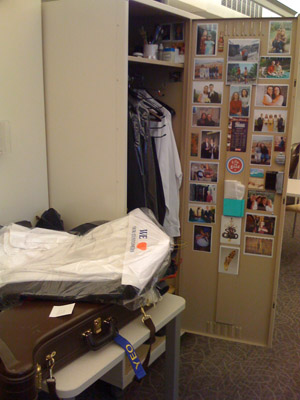 Today I played my last concert with the
Boston Symphony Orchestra
before I embark on my sabbatical half-year. For the last two weeks, the Boston Symphony has been
wearing its "other hat" as the Boston Pops Orchestra. Our "Holiday Pops" concerts take up most of the month of December, with a combination of required (quota) concerts
and optional (non-quota) concerts. I played 18 concerts and two rehearsals and at 12:15 pm today, with the last chord of "Let There Be Peace on Earth", I put down
my trombone and have begun my sabbatical. Strictly speaking my sabbatical does not begin officially for a few weeks, in mid-January, but I have some vacation weeks
in the interim, so I effectively begin my sabbatical now.
Today I played my last concert with the
Boston Symphony Orchestra
before I embark on my sabbatical half-year. For the last two weeks, the Boston Symphony has been
wearing its "other hat" as the Boston Pops Orchestra. Our "Holiday Pops" concerts take up most of the month of December, with a combination of required (quota) concerts
and optional (non-quota) concerts. I played 18 concerts and two rehearsals and at 12:15 pm today, with the last chord of "Let There Be Peace on Earth", I put down
my trombone and have begun my sabbatical. Strictly speaking my sabbatical does not begin officially for a few weeks, in mid-January, but I have some vacation weeks
in the interim, so I effectively begin my sabbatical now.
I admit that it was a strange feeling to pack up some things from my locker (shown at right) and close the door, knowing that I would not be coming back to Symphony Hall for several months. I am very blessed to have a job such as I have as a member of the Boston Symphony. As bass trombonist of the orchestra since 1985, I have had the opportunity to live a dream and to make music at the highest level with some of the world's greatest conductors and soloists in the world's greatest concert hall with some inspiring, gifted colleagues. I will miss this, while at the same time am looking forward to an exciting few months ahead. In particular I will miss spending time with the Boston Symphony's new principal trombonist, Toby Oft (pictured at left, on stage after today's concert). Since Toby joined the BSO this past fall, we have been enjoying a musical relationship and friendship that has been moving at the speed of light. It is exciting to have "new blood" in the section and Toby brings great ideas and energy to us. We share a lot of common interests and have spent a lot of time together at Symphony Hall exploring these interests and enjoying conversation about same.
But we will keep in touch. I will continue to do my teaching at New England Conservatory of Music next semester so I will find myself in the neighborhood of Symphony Hall on occasion; when that happens, Toby and I will take time to catch up. As I walk past Symphony Hall, I'll be aware that someone else will be sitting in my chair for a few months. But the nice thing for me is that I get to come back to all of that in July, when the BSO is at Tanglewood for its summer season. I have the best of all possible worlds in all of this - time away for refreshment and exploration and the assurance that I can come back to the job that I love so much.
After I left Symphony Hall, I drove home, aware that one of the nice bonuses of my sabbatical will be having a break from the daily commute on Boston's often challenging roads. This evening, my wife and I went to a Christmas Eve service at our church, Redeemer Presbyterian Church, in Concord, Massachusetts, where we played an arrangement of "O Come, O Come Emmanuel" which I recorded on my CD, Cornerstone. Somehow it was appropriate that on this, my last day at work with the BSO before my sabbatical, the last thing I played on the trombone was a sacred work that has deep personal meaning to me.
Tomorrow, Christmas Day, our daughters and son-in-law arrive for a few days and we will have laughter and celebration in the house. And I shall take a day off from playing the trombone. The adventure begins!
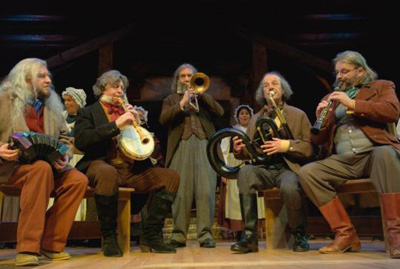 In my life as bass trombonist of the Boston Symphony, I don't have opportunities to attend many concerts. Because I play so many concerts myself and
most of my evenings are taken up with those concerts, there are many events that I just can't attend even if I wanted to. I confess, too, that because I enjoy
performing so much, when I DO attend a concert as an audience member, I am often a bit fidgety as I wish I was up on stage too, performing and
taking part in the fun.
In my life as bass trombonist of the Boston Symphony, I don't have opportunities to attend many concerts. Because I play so many concerts myself and
most of my evenings are taken up with those concerts, there are many events that I just can't attend even if I wanted to. I confess, too, that because I enjoy
performing so much, when I DO attend a concert as an audience member, I am often a bit fidgety as I wish I was up on stage too, performing and
taking part in the fun.
One of the great joys of this sabbatical time is the ability to have evenings free to do different things, including attend concerts. Over the last week, I've had a couple of such opportunities that have given me a lot to think about.
Elsewhere on my website I write about my friendship with Phil Humphries, a trombone and serpent player from Dorset, England, who is a member of The Mellstock Band. The Band serves to recreate the sound and times of English author Thomas Hardy who wrote many books and poems about English country life in the 19th century even as many aspects of that life were beginning to fade away. Last week I had the pleasure of spending time with Phil and giving a pre-concert talk with him at Cambridge's Christmas Revels which have been going on annually in the month of December for over three decades. The photo at left (by Roger Ide, courtesy The Revels) shows The Mellstock Band at the Revels, with, from left, leader Dave Townsend (concertina), Charles Spicer (oboe), Phil Humphries (serpent) and Tim Hill (clarinet); in the middle they are joined by trombonist Bruce Randall. I thoroughly enjoyed my talks with Phil and I stayed to hear one of their concerts last week. Last night I returned to hear them again and came away mightily impressed on a number of levels.
In our 6000 channel universe, with so many things competing for our time and attention, we often find ourselves sucked into the vortex of modernity, with everything moving at an ever quicker pace. Especially at this time of year, when one is confronted with endless advertising from retailers, bright and flashing lights and kitchy "seasonal displays", it is easy to get caught up in a feelling that what is going around is terribly false, even phoney, and we long for something that is authentic. Ahh, authenticity. It is a something that is not easy to grasp these days. But I found it at the Revels and in the Mellstock Band and I awoke this morning refreshed with the thought that I had witnessed something very special and that I had been a part of something that was truly authentic.
 The refreshing, earthy sounds of the early oboe, clarinet, concertina and serpent were truly music to my ears. In a world where most of the music we hear is
highly polished and produced, there is something very honest about the presentation of folk music presented in a way that is unpretentious. The truth is that most
music in the world is made in such a way - in town bands, around fires in tribal villages, in church choirs, and in amateur groups of all stripe. The highly
professional and polished music of the Boston Symphony is not "better" than the rough hewn, earthy tones of The Mellstock Band. It is just different. And to have
ears to enjoy both is a gift.
The refreshing, earthy sounds of the early oboe, clarinet, concertina and serpent were truly music to my ears. In a world where most of the music we hear is
highly polished and produced, there is something very honest about the presentation of folk music presented in a way that is unpretentious. The truth is that most
music in the world is made in such a way - in town bands, around fires in tribal villages, in church choirs, and in amateur groups of all stripe. The highly
professional and polished music of the Boston Symphony is not "better" than the rough hewn, earthy tones of The Mellstock Band. It is just different. And to have
ears to enjoy both is a gift.
The authenticity of The Mellstock Band is very refreshing, and my time at the Revels brought together many diverse threads of thought. There I was, in a room with 1000 people, enjoying a re-creation of scenes from 19th century English village life. There was singing, playing, dancing and a play. Children were part of this. And throughout, the audience was engaged in a wonderful way. The Revels have a number of things that are done each year - traditions of involving the audience in singing carols and rounds - and when the first half concluded with singing of The Lord of the Dance, I found my hands grabbed by those around me as we stood up and danced out of the hall to the lobby for intermission. Such spontaneity! To be dancing through the hall singing a hymn to Christ, "Dance, then, wherever you may be; I am the lord of the dance, said he..." had me smiling from ear to ear.
After the concert, we went to a local tavern for more conversation and fun. Sitting with Phil, Charles and Tim along with my wife and oldest daughter was a delighful way to conclude such a nice evening. Phil and I exchanged some gifts - he giving me the complete poems of Thomas Hardy (what a treasure!) and I giving him a figurine of a Victorian era serpent player (he had never seen anything like it) - and shared a pint - see the photo above at right.
All of this was a great way to begin my sabbatical. Authentic music authentically performed, in a room with appreciative, engaged listeners, and being with friends and family. As I close this entry in my sabbatical diary, I would like to share with you my favorite Thomas Hardy poem, one which I first heard on the Mellstock Band recording, The Dance at the Phoenix. I had asked Phil if he would recite it as part of our pre-Revels talks about the serpent and he did so with great style. And sincerity. And authenticity. I leave it with you for your contemplation.
The Choirmaster's Burial by Thomas HardyHe often would ask us that, when he died,
After playing so many to their last rest,
If out of us any should here abide, and it would not task us,
We would with our lutes play over him by his grave-brim the psalm he liked best -
The one whose sense suits "Mount Ephriam" -
And perhaps we should seem to him, in Death's dream, like the seraphim.As soon as I knew that his spirit was gone, I thought this his due, and spoke thereupon.
"I think," said the vicar, "A read service quicker than viols out-of-doors in these frosts and hoars.
That old-fashioned way requires a fine day, and it seems to me it had better not be."Hence, that afternoon, though never knew he that his wish could not be,
To get through it faster they buried the master without any tune.But 'twas said that, when, at the dead of next night the vicar looked out,
There struck on his ken thronged roundabout,
Where the frost was graying the headstoned grass,
A band all in white, like the saints in church-glass,
Singing and playing the ancient stave by the choirmaster's grave.Such the tenor man told when he had grown old.
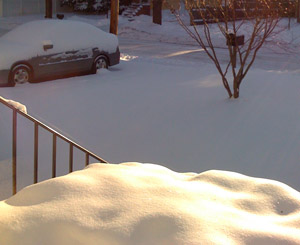 The new year dawned with a fresh coat of eight inches of snow outside my living room window. Wind blown, my view had a quiet quality to it - no cars were driving in the street,
no sand or salt had yet been put on my street. Our cars were covered with snow and our driveway and walkways invisible. It was a nice view to start the new year -
fresh, pure, unspoiled. As the morning went on, we gathered shovels and fired up our snowblower to clear the paths and rescue our cars from their entombment.
The new year dawned with a fresh coat of eight inches of snow outside my living room window. Wind blown, my view had a quiet quality to it - no cars were driving in the street,
no sand or salt had yet been put on my street. Our cars were covered with snow and our driveway and walkways invisible. It was a nice view to start the new year -
fresh, pure, unspoiled. As the morning went on, we gathered shovels and fired up our snowblower to clear the paths and rescue our cars from their entombment.
 The purity of the snow gave way to practical matters - stoking up our wood burning stove, preparing breakfast, and turning on my computer to see what the overnight
had brought into my email
"IN" box. Among the messages that greeted me was one from Justin St. Vincent, a musician in New Zealand who had asked me in 2007 if I would contribute a chapter to
a project he was planning on the subject of
The Spiritual Significance of Music.
The purity of the snow gave way to practical matters - stoking up our wood burning stove, preparing breakfast, and turning on my computer to see what the overnight
had brought into my email
"IN" box. Among the messages that greeted me was one from Justin St. Vincent, a musician in New Zealand who had asked me in 2007 if I would contribute a chapter to
a project he was planning on the subject of
The Spiritual Significance of Music.
Originally planned to be a book, The Spiritual Significance of Music has been released as a website that posed this question to musicians from around the world:
What do you believe is the spiritual significance of music?
As I was intrigued by the question, I agreed to participate.
As it has been released today (January 1), The Spiritual Significance of Music contains over 500 interviews of performers, authors, composers and scholars. The project has been divided into four "editions" with responses fitting in the categories of Christian, World, Authors and Metal. There is a strong representation from the heavy metal music industry, both Christian and secular, and there is overlap between the sections (for instance, a Christian entry may appear only in Author, a Metal entry may appear in Christian, etc).
The wide range of answers to the question provide some thought provoking discussion points. Even within the Christian section, there are many views expressed.
While I certainly don't endorse the complete content of the book and all of the views expressed (I find some to be widely off mark and ill-informed, while others are thoughtful and interesting), I wanted to let you know about this new online resource. You can view all of the articles at The Spiritual Significance of Music Website. My contribution may be found in the Christian Edition section and can also be referenced directly by clicking HERE. All chapters are available as downloadable PDF files. Happy reading!
 As a student of history, I often think what it would be like to go back in time to the 13th, or 18th, or 19th century. There is so much I could learn from
even a few minutes of time travel! But when it comes to actually living in a particular time and place, I am very grateful I was born in the middle of the 20th century and
am a beneficiary of modern medical care.
As a student of history, I often think what it would be like to go back in time to the 13th, or 18th, or 19th century. There is so much I could learn from
even a few minutes of time travel! But when it comes to actually living in a particular time and place, I am very grateful I was born in the middle of the 20th century and
am a beneficiary of modern medical care.
I write this entry on my MacBook laptop, sitting in my favorite chair, our wood stove burning, our cats asleep on the sofa across the room. And on my right knee is an aircast full of iced water. I had knee surgery today.
 Beginning my sabbatical with surgery was not exactly a planned event, but several months ago, I began experiencing sharp pain in my right knee, especially when
I would plant my foot and then go to turn. In August 2005, I had surgery on my left knee to repair what was diagnosed as a torn meniscus - the layer of
cartilage between the two bones of your knee, behind the knee cap. That surgery was done at Beth Israel Deaconess Hospital in Boston and I was under the expert
care of one of the pioneers and leaders of the whole field of sports medicine,
Dr. Lyle Micheli. I had never had surgery of any kind before, and Dr. Micheli's
work led to a quick recovery and complete resolution of the issue. When, a few months ago, I began to experience the same kind of pain in my right
knee, I had a feeling a similar procedure would be in order.
Beginning my sabbatical with surgery was not exactly a planned event, but several months ago, I began experiencing sharp pain in my right knee, especially when
I would plant my foot and then go to turn. In August 2005, I had surgery on my left knee to repair what was diagnosed as a torn meniscus - the layer of
cartilage between the two bones of your knee, behind the knee cap. That surgery was done at Beth Israel Deaconess Hospital in Boston and I was under the expert
care of one of the pioneers and leaders of the whole field of sports medicine,
Dr. Lyle Micheli. I had never had surgery of any kind before, and Dr. Micheli's
work led to a quick recovery and complete resolution of the issue. When, a few months ago, I began to experience the same kind of pain in my right
knee, I had a feeling a similar procedure would be in order.
With my sabbatical on the horizon, scheduling this procedure took a little bit of doing. I was fortunate that all of the appointments I needed leading up to today's surgery were able to happen in rapid succession. Because of my experience with the same procedure a few years ago, I thought it was likely I would be back on my feet rapidly so would be able to head to England as planned next week. All signs point to that being the case.
This was arthroscopic surgery but required that I be put under general anesthesia. Fortunately, the procedure took only 45 minutes and I experienced no ill affects from the anesthesia. In years past, this procedure called for complete removal of the cartilage (which often led to arthritis) but today, the procedure is minimally invasive and only the smallest bit of cartilage is cut away, preserving this important cushion between my knee bones.
My wife is a nurse but I know hardly a thing about things medical. So don't ask me to interpret the photos at right that Dr. Micheli took inside my knee this afternoon (I do know that the upper left photo shows my two knee bones with the miniscus inbetween). It's enough for me that he's happy with the result - he pointed to this and that in the various photos, saying what was wrong and how it was cared for, and, most important, that he is pleased with how things went. There's a little bit of a feeling of being in the movie Fantastic Voyage when I see photos or videos that were taken inside my body - a somewhat surreal sensation as I consider how all parts of my body work together in harmony, having been, in the words of the Psalmist, "fearfully and wonderfully made." And while I am grateful that I had such good care from my physician and all of the staff at Beth Israel Deaconess, I am also grateful that I am in the hands of the Almighty God, the greatest physician who holds my life in His hands and orders my days.
A few quiet days at home with my leg up, continuous replenishing of the ice water in my air cast and I will be moving around soon and, Lord willing, back to myself. I extend my thanks to my family and friends who were praying for me during the procedure and with this all in my rear-view mirror, am looking forward to upcoming activities and travels!
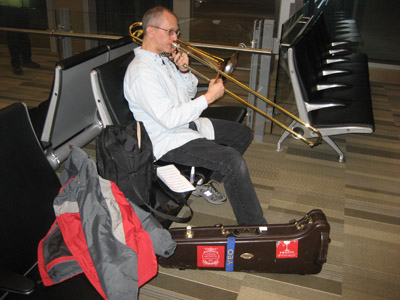 I returned yesterday from the first major trip of my sabbatical period - a trip to England. My wife accompanied me on this 11 day journey that took us in a large circle
through the middle of Great Britain.
I returned yesterday from the first major trip of my sabbatical period - a trip to England. My wife accompanied me on this 11 day journey that took us in a large circle
through the middle of Great Britain.
Our trip began in Boston where we flew to Raleigh, North Carolina before heading to London's Heathrow airport. As I was using frequent flyer miles for this trip, we were not able to get the direct flight from Boston to Heathrow (although we did fly direct on our return). Flying to Raleigh meant a longer trip (with a long layover) so when confronted with a few free hours in an airport with trombone in tow, it seemed logical to find an empty gate area, put in my practice mute and got in an hour of practicing (left).
 Upon arrving in London, we rented a car and drove west to Wiltshire, home of our good friends Roger and Frances. Roger, a retired school teacher, is a bass trombone
and brass band enthusiast. We have shared many vacations on both sides of the pond over the years and it was good to see our friends, catch up from our jet
lag and enjoy a very meaningful Sunday morning worship service in Bath Abbey.
Upon arrving in London, we rented a car and drove west to Wiltshire, home of our good friends Roger and Frances. Roger, a retired school teacher, is a bass trombone
and brass band enthusiast. We have shared many vacations on both sides of the pond over the years and it was good to see our friends, catch up from our jet
lag and enjoy a very meaningful Sunday morning worship service in Bath Abbey.
A few days later we travelled north to the village of Treeton in South Yorkshire, near Sheffield. Yorkshire is the part of Britain where many of the most famous and best brass bands were founded; bands like the Black Dyke Mills Band, Fairey Aviation Works Band and Grimethorpe Colliery Band. Two of my CDs were recorded in Manchester and it was nice to get back in that part of the country to visit our friends, Esther and Peter. Peter is a pastor at a small Baptist church and we enjoyed a day together in York, visiting the famous Minster (Cathedral) despite the typically British cold and wet weather.
Our travels then brought us all the way across England to the east coast, to Skegness on the North Sea. Two years ago, I had been to the Butlins Resort at Skegness to help raise money for the charity Brass Band Aid. I made many friends on that trip, principal among them being Jon Handley of Tor Designs of Leeds. Tor Designs is the leading supplier of uniforms, casual wear and stand banners for brass bands around the world. Tor has recently made forays into the North American market by attending our annual North American Brass Band Association championships. When I was music director of the New England Brass Band, the NEBB obtained a beautiful set of banners from Tor.
 Jon is the kind of person who is always working to find a new way to get things done. His mind moving at the speed of light, he asked me if I would be interested in coming back
to Skegness for the 2009 Mineworker's Open Brass Band Contest and helping to raise money for this year's charity, the National Youth Brass Band of Great
Britain and the National Children's Brass Band of Great Britain. It didn't take long for me to say YES!, especially because Jon had an idea to
organize a trombone ensemble as part of this charity project. When I went to Butlin's in 2007, I took part in organizing "The Big Blow", a Guinness World Record
attempt to organize the world's largest certified brass band to raise money for
Brass Band Aid.
This time, Jon asked if I could organize "Bone Blow 2009". Band Supplies, a leading instrument and
accessory dealer in Britain, donated a Bach trombone for a raffle to benefit the NYBBGB and NCBBGB. Trombonists from the participating bands at the contest -
there were nearly 100 bands on site for the weekend - were invited to participate. I confess to a little trepidation in the 30 minutes before our rehearsal. We had no
idea how many players might show up. So when it came time for me to give my downbeat, we were all so pleased that exactly 50 trombonists had come to take part in
the event. We rehearsed three pieces: two arrangements by
Stephen Bulla
- the hymn tune "Slane" (to which the great hymn Be Thou My Vision is often sung),
"Londonderry Air", and an arrangement of "76 Trombones" by
Ken Amis.
After an hour of polishing the pieces (see the photo at left), we turned to our performance. Jon, along with the
Butlin's resort's director of entertainment, Steve Walker, had set it up for the "Bone Blow 2009" to take place just before the award ceremony for the brass band
contest. This was great timing that ensured a huge audience for our performance. The players all did a fantastic job on the music and we were all very well received.
Another happy part of this was the over �500 that was raised for the NYBBGB and NCBBGB, and the trombone was raffled to a woman whose young daughter played trombone
and was very much in need of a new instrument.
Jon is the kind of person who is always working to find a new way to get things done. His mind moving at the speed of light, he asked me if I would be interested in coming back
to Skegness for the 2009 Mineworker's Open Brass Band Contest and helping to raise money for this year's charity, the National Youth Brass Band of Great
Britain and the National Children's Brass Band of Great Britain. It didn't take long for me to say YES!, especially because Jon had an idea to
organize a trombone ensemble as part of this charity project. When I went to Butlin's in 2007, I took part in organizing "The Big Blow", a Guinness World Record
attempt to organize the world's largest certified brass band to raise money for
Brass Band Aid.
This time, Jon asked if I could organize "Bone Blow 2009". Band Supplies, a leading instrument and
accessory dealer in Britain, donated a Bach trombone for a raffle to benefit the NYBBGB and NCBBGB. Trombonists from the participating bands at the contest -
there were nearly 100 bands on site for the weekend - were invited to participate. I confess to a little trepidation in the 30 minutes before our rehearsal. We had no
idea how many players might show up. So when it came time for me to give my downbeat, we were all so pleased that exactly 50 trombonists had come to take part in
the event. We rehearsed three pieces: two arrangements by
Stephen Bulla
- the hymn tune "Slane" (to which the great hymn Be Thou My Vision is often sung),
"Londonderry Air", and an arrangement of "76 Trombones" by
Ken Amis.
After an hour of polishing the pieces (see the photo at left), we turned to our performance. Jon, along with the
Butlin's resort's director of entertainment, Steve Walker, had set it up for the "Bone Blow 2009" to take place just before the award ceremony for the brass band
contest. This was great timing that ensured a huge audience for our performance. The players all did a fantastic job on the music and we were all very well received.
Another happy part of this was the over �500 that was raised for the NYBBGB and NCBBGB, and the trombone was raffled to a woman whose young daughter played trombone
and was very much in need of a new instrument.
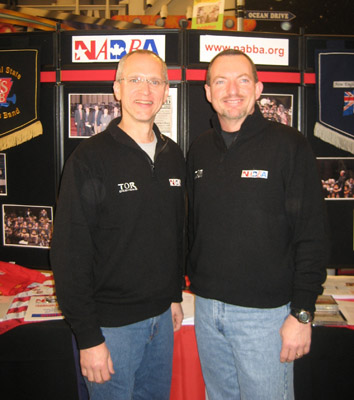 In addition to the "Bone Blow 2009", I took pat in a live "chat show" with brass band legend Stan Lippeatt. Part of this show was my playing with the house
rock band; I chose to play Bill Pearce's arrangement of Joshua fit the battle of Jericho, a real tour de force for the trombone arranged in a way that exploited my
bass trombone low range rather than Bill's stratospheric high range.
In addition to the "Bone Blow 2009", I took pat in a live "chat show" with brass band legend Stan Lippeatt. Part of this show was my playing with the house
rock band; I chose to play Bill Pearce's arrangement of Joshua fit the battle of Jericho, a real tour de force for the trombone arranged in a way that exploited my
bass trombone low range rather than Bill's stratospheric high range.
Another part of the weekend was representing the North American Brass Band Association at the Butlin's contest. Along with my good friend, NABBA President Rusty Morris (conductor of the Natural State Brass Band in Little Rock, Arkansas - photo at right), NABBA had two tables in the vendor area at the contest where we developed many relationships with brass band players, conductors and other vendors in an effort to build partnerships between bands in North America and the United Kingdom (I should mention that I currently serve as NABBA's vice-president). Once again, Jon Handley was instrumental in making this all happen. He donated the display space for us and he and Rusty created an attractive display that gave a sense of what brass bands in North America were doing. Music stand banners from many North American brass bands as well as photos of our NABBA contests provided focal points for the display. Rusty had asked North American bands if they would donate CDs to give away to visitors to the trade stand. In all, hundreds of CDs, pins, banners and other items were given away in a show of good will toward our brass band friends in the UK. Jon also made up some shirts, jackets and sweaters that commemorated the visit and as a result, we were able to meet many, many people and talk about NABBA's goals and aims. We built many good relationships and look forward to reaping the fruit of this exciting time we had in Skegness.
A bonus of the weekend was being able to attend not only performance of many of the nearly 100 competing bands, but also special concerts by the 2008 Butlin's champion, the Desford Band (conducted by Russell Gray), the Grimethorpe Colliery Band (conducted by Frank Renton) and current British Open Champions, the Foden's Band (also conducted by Russell Gray). These performances were memorable highlights in a jam-packed weekend. Rusty and I (along with our wives) left Butlins tired but very satisfied that we had gotten the most out of the weekend. We cannot thank Jon Handley and Steve Walker enough for all they did to make our time in Skegness productive, exciting and very satisfying.
 Our next destination was Boston, England. When visiting Butlins in 2007, I took the train from London up to the north and the train had a brief stop in Boston. I
was stunned to see a tremendous gothic style church tower - a lone tower that seemed to stretch up to heaven. I was intrigued by this tremendous building and after some research, discovered that Boston, England
was the place where many of the Pilgrims that came to America on the Mayflower in 1620 came from. Boston was a center of Puritan activity and had the Pilgrims
not been forced into exile in the Netherlands before they were to set sail for America, they would have left from Boston rather than from Plymouth. Boston's
church of St. Botolph (from whom the word "Boston" comes from) is England's largest parish church. Consisting of a long nave and its massive tower, it is a beautiful building
dating from the 13th century. There were many monuments and stained glass windows that told of the Puritan influence and of the journey of the Mayflower. The plaque
shown at left honors the five men from Boston, England who served as Governor of Boston, Massachusetts in the pre-Revolutionary war time. The building was rich with such
history.
Our next destination was Boston, England. When visiting Butlins in 2007, I took the train from London up to the north and the train had a brief stop in Boston. I
was stunned to see a tremendous gothic style church tower - a lone tower that seemed to stretch up to heaven. I was intrigued by this tremendous building and after some research, discovered that Boston, England
was the place where many of the Pilgrims that came to America on the Mayflower in 1620 came from. Boston was a center of Puritan activity and had the Pilgrims
not been forced into exile in the Netherlands before they were to set sail for America, they would have left from Boston rather than from Plymouth. Boston's
church of St. Botolph (from whom the word "Boston" comes from) is England's largest parish church. Consisting of a long nave and its massive tower, it is a beautiful building
dating from the 13th century. There were many monuments and stained glass windows that told of the Puritan influence and of the journey of the Mayflower. The plaque
shown at left honors the five men from Boston, England who served as Governor of Boston, Massachusetts in the pre-Revolutionary war time. The building was rich with such
history.
 Life is always full of unexpected surprises. While walking under the great tower on the east end of the church, I saw a monument in the floor (photo at right).
Could this be true - could John Taverner, one of the greatest Renaissance composers, be buried under my feet? Sure enough, the great composer settled in Boston
during the last years of his life, even serving as an alderman at Boston's church of St. Botolph. The serendipitous discovery that such a great composer was
buried in Britain's largest parish church that bears the name of my home city was exciting. I recall the feeling I had when I first visited Westminster Abbey in
London, with monuments and graves of so many famous musicians, poets and authors. To find Taverner's final resting place in this remote part of Lincolnshire
was a great suprise and one that gave me much on which to contemplate.
Life is always full of unexpected surprises. While walking under the great tower on the east end of the church, I saw a monument in the floor (photo at right).
Could this be true - could John Taverner, one of the greatest Renaissance composers, be buried under my feet? Sure enough, the great composer settled in Boston
during the last years of his life, even serving as an alderman at Boston's church of St. Botolph. The serendipitous discovery that such a great composer was
buried in Britain's largest parish church that bears the name of my home city was exciting. I recall the feeling I had when I first visited Westminster Abbey in
London, with monuments and graves of so many famous musicians, poets and authors. To find Taverner's final resting place in this remote part of Lincolnshire
was a great suprise and one that gave me much on which to contemplate.
 Upon leaving Boston and its famous "Stump" (the St. Botolph church is affectionately known as "The Stump" for reasons that are now lost to antiquity), we traveled south and
east to Norfolk to visit my dear friend, Kathryn Rogers. Readers of my website know of my friendship with the late
Keith Rogers,
serpent maker for Christopher
Monk Instruments. Keith lived in the little village of Yaxham in Norfolk. My wife and I went there to visit his wife, Kathryn for a few days. The visit was rich
in many ways. Not the least of which was the opportunity to play Keith's own serpent (that I had played in a concert in his memory in London last April) at his
graveside. I played one of his favorite hymns, "Lead Kindly Light," one of the most popular hymns of the Victorian era. Walking in the ancient churchyard of
St. Peter's church in Yaxham - where I had worshipped with Kathryn among their friends in September, 2007, during my last visit with Keith before he died in
January, 2008 - was an emotional and meaningful experience for me.
Upon leaving Boston and its famous "Stump" (the St. Botolph church is affectionately known as "The Stump" for reasons that are now lost to antiquity), we traveled south and
east to Norfolk to visit my dear friend, Kathryn Rogers. Readers of my website know of my friendship with the late
Keith Rogers,
serpent maker for Christopher
Monk Instruments. Keith lived in the little village of Yaxham in Norfolk. My wife and I went there to visit his wife, Kathryn for a few days. The visit was rich
in many ways. Not the least of which was the opportunity to play Keith's own serpent (that I had played in a concert in his memory in London last April) at his
graveside. I played one of his favorite hymns, "Lead Kindly Light," one of the most popular hymns of the Victorian era. Walking in the ancient churchyard of
St. Peter's church in Yaxham - where I had worshipped with Kathryn among their friends in September, 2007, during my last visit with Keith before he died in
January, 2008 - was an emotional and meaningful experience for me.
Keith's own serpent was made of plum wood and covered with a genuine python skin. (The skin dates to the 1940s when a resident of a colonial African country was forced to leave at short notice. Unable to take money out of the country, he purchased goods including several python skins which he sold to the late Christopher Monk and then on to Keith Rogers. These skins were acquired long before the ban on such things which makes Keith's instrument - that has all of the necessary legal provenance - tremendously unique.) I own two serpents made by Keith; a French church serpent after Baudouin made in 1996 and an England Military serpent after Pretty made in 2007. Being in Keith's workshop again and in his home - surrounded as it is by so many memories of our friendship and conversations - was a highlight of the trip.
Having said good-bye to Kathyrn, we found ourselves driving back to Heathrow Airport and heading back home to Boston. While we were away, we had missed three major snow storms and a record break cold snap. On hearing that (and with gratitude to our neighbor who had borrowed my snow blower and ensured we could get into our driveway and house), our days in cold and wet England seemed almost balmy. Life is all about comparisons and references, and our time in England has left me with a great many memories and thoughts. Good friends, good food, rewarding activities and memorable experiences all made for a very satisfying trip. And while it is always good to go away and enjoy a different part of the world, it is also good to get back home to the familiar. There is lots to catch up on - mail to open, email to answer, shopping to do and of course more practicing to undertake as I get ready for the next adventures on this sabbatical journey.
I write this entry on American Airlines flight 194, from San Francisco en route to Boston. This first working trip of my sabbatical was a tremendous success on every level and in the process I got to combine several things that give me great pleasure: visit with close friends and family members, give a trombone masterclass, guest conduct fine brass bands, and play an historical brass instrument with an excellent early music orchestra. Combine that with some beautiful weather on the west coast and the making of some new friendships and you can see why it is so rewarding to write this entry.
My trip began on January 29 in Seattle, where I arrived in advance of the Northwest International Brass Band Festival. Trips to Seattle are always a pleasure as it means I can spend time with one of my closest friends, my Wheaton college classmate Timothy Salzman, who is director of bands at University of Washington. Tim and I go back to 1974 where we were played in the College band and orchestra together (Tim was a fine tuba player at the time), Tim accompanied me on my senior trombone recital (his piano playing can be heard on my CD Take 1 in a performance of Donald White's Tetra Ergon) and we later were next door neighbors in Wheaton's married student housing. Tim had set up a masterclass for me at University of Washington and the class, held in a large and surprisingly crowded lecture hall on campus, gave me an opportunity to talk about some important playing concepts, do some playing myself to demonstrate the ideas, and then work with some talented students.
Over the following weekend, I was guest conductor and clinician at the Northwest International Brass Band Festival. Hosted by Seattle's Brass Band Northwest and organized by Brass Band Northwest's former artistic director, Steve Keene, the Festival brought together four brass bands from the Pacific Northwest for a day of rehearsals, clinics and performances. This was the seventh year of the Festival which has attracted some of the leading names in brass banding as guest conductor and clinician, including Philip Sparke, James Curnow and Frank Renton. I was honored to be asked to join that distinguished company to work with each band throughout the day.
The Festival's format had each band take the stage in the morning and afteroon to rehearse and then be led by me in several pieces in a clinic setting. Later in the evening, each band took the stage as part of a gala concert to present a 30 minute program that included my guest conducting each group. The photo at left shows me with the Salvation Army's Seattle Temple Band.
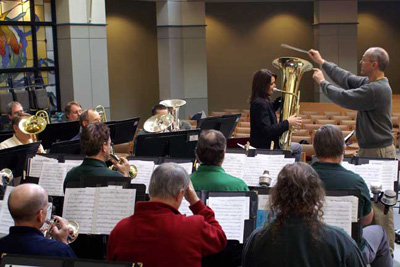 A special treat of the day was the presence of Deanna Swoboda, professor of tuba at Western Michigan University. I had known of Deanna by reputation,
mostly from her days as tubist with the Dallas Brass, and it was a pleasure to meet and work with her. The host band, Brass Band Northwest, accompanied
Deanna in two solos - Rodney Newton's Capriccio and the virtuosic violin solo, Czardas with me on the podium. Deanna was a consummate
professional. She is a rare person who has tremendous talent, an engaging personality, and an infectious, positive attitude in all that she does. From
the moment we began working together, our collaboration with Brass Band Northwest just "clicked." Deanna made the tuba sound like a flexible, supple
solo instrument, infused with a beautiful sound, blistering technique and a bag full of flourishes that impressed and delighted the gala concert audience.
During the day, Deanna also gave several clinics for band members who were not rehearsing with me and from all reports, those clinics were well attended and
well received.
A special treat of the day was the presence of Deanna Swoboda, professor of tuba at Western Michigan University. I had known of Deanna by reputation,
mostly from her days as tubist with the Dallas Brass, and it was a pleasure to meet and work with her. The host band, Brass Band Northwest, accompanied
Deanna in two solos - Rodney Newton's Capriccio and the virtuosic violin solo, Czardas with me on the podium. Deanna was a consummate
professional. She is a rare person who has tremendous talent, an engaging personality, and an infectious, positive attitude in all that she does. From
the moment we began working together, our collaboration with Brass Band Northwest just "clicked." Deanna made the tuba sound like a flexible, supple
solo instrument, infused with a beautiful sound, blistering technique and a bag full of flourishes that impressed and delighted the gala concert audience.
During the day, Deanna also gave several clinics for band members who were not rehearsing with me and from all reports, those clinics were well attended and
well received.
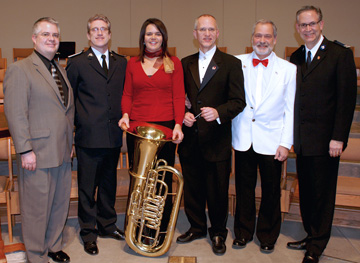 The four bands that participated in the Festival - Brass Band Northwest (from Bellevue, Washington, Steve Keene, Artistic Director Emeritus and Guest Conductor
pf BBNW for this concert),
PugetBrass (from Seattle, Washington, John Falskow, Conductor), Seattle Temple Band of the Salvation Army (from Seattle, Washington, Stefan Wennstig,
Bandmaster) and Cariboo Hill Temple Band of the Salvation Army (from Burnaby, British Columbia, Dave Michel, Bandmaster) - were all accomplished groups with
a great love and enthusiasm for brass banding. Working with each band brought particular pleasures, and each conductor asked me to conduct a piece
that had personal meaning for me. In addition to conducting Brass Band Northwest in Deanna's solos, I led Cariboo Temple Band in
Dean Goffin's, Arise, My Soul, Arise, Seattle Temple in Robert Redhead's Reflections in Nature and PugetBrass in Clement Scholefield's great
Victorian-era hymn tune, St. Clement, which is paired with the hymn The Day Thou Gavest, Lord, Is Ended. The photo at left shows all of the leaders of
the participating bands (left to right): John Falskow, Stefan Wennstig, soloist Deanna Swoboda, myself, Steve Keene and Dave Michel.
The four bands that participated in the Festival - Brass Band Northwest (from Bellevue, Washington, Steve Keene, Artistic Director Emeritus and Guest Conductor
pf BBNW for this concert),
PugetBrass (from Seattle, Washington, John Falskow, Conductor), Seattle Temple Band of the Salvation Army (from Seattle, Washington, Stefan Wennstig,
Bandmaster) and Cariboo Hill Temple Band of the Salvation Army (from Burnaby, British Columbia, Dave Michel, Bandmaster) - were all accomplished groups with
a great love and enthusiasm for brass banding. Working with each band brought particular pleasures, and each conductor asked me to conduct a piece
that had personal meaning for me. In addition to conducting Brass Band Northwest in Deanna's solos, I led Cariboo Temple Band in
Dean Goffin's, Arise, My Soul, Arise, Seattle Temple in Robert Redhead's Reflections in Nature and PugetBrass in Clement Scholefield's great
Victorian-era hymn tune, St. Clement, which is paired with the hymn The Day Thou Gavest, Lord, Is Ended. The photo at left shows all of the leaders of
the participating bands (left to right): John Falskow, Stefan Wennstig, soloist Deanna Swoboda, myself, Steve Keene and Dave Michel.
 As if all of this was not enough, the evening concert concluded with a massed band performance of William Gordon's arrangement of Ralph Vaughan Williams' tune
to God Be With You. Performed with the 100 players arrayed around the perimeter of the sanctuary at First Presbyterian Church of Bellevue, Washington,
the sound was breathtaking. A bonus was the fact that Bill Gordon was present as well (pictured at right); he plays bass trombone in the Cariboo Temple Band. During my
years as Music Director of the
New England Brass Band,
I performed a great deal of Bill's music. We recorded several of his works including his Fortress (which the NEBB played on our winning program
when we won the Challenge Section at the 2004 North American Brass Band Association Championships), God Be With You and his trombone solo,
My Lord, What a Morning. It was a delight to finally meet Bill and shake his hand, and put a face and voice with someone whose music I had
gotten to know so well over the years.
As if all of this was not enough, the evening concert concluded with a massed band performance of William Gordon's arrangement of Ralph Vaughan Williams' tune
to God Be With You. Performed with the 100 players arrayed around the perimeter of the sanctuary at First Presbyterian Church of Bellevue, Washington,
the sound was breathtaking. A bonus was the fact that Bill Gordon was present as well (pictured at right); he plays bass trombone in the Cariboo Temple Band. During my
years as Music Director of the
New England Brass Band,
I performed a great deal of Bill's music. We recorded several of his works including his Fortress (which the NEBB played on our winning program
when we won the Challenge Section at the 2004 North American Brass Band Association Championships), God Be With You and his trombone solo,
My Lord, What a Morning. It was a delight to finally meet Bill and shake his hand, and put a face and voice with someone whose music I had
gotten to know so well over the years.
More photos from the 2009 Northwest Internal Brass Band Festival may be found by clicking HERE.
From Seattle I traveled to San Francisco for a week of performances with one of the world's finest period-instrument early music groups, Philharmonia Baroque
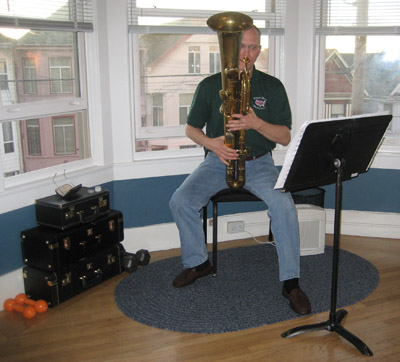 In 1994, I began my foray into historical instrument performance when I played serpent in Berlioz's Messe solennelle with the Boston Symphony
conducted by Seiji Ozawa. Since that time, I have enjoyed playing serpent, ophicleide and bass sackbut with early music groups around the country
(I tell some of this story in my article,
Tempted by a Serpent).
When Philharmonia Baroque asked if I was available to play ophicleide in performances of Mendelssohn's A Midsummer Night's Dream, I was
delighted my schedule allowed me to accept the engagement. A particularly nice aspect of this was being able to stay with my youngest daughter, Robin
(who works in public relations for San Francisco Opera), and her husband John (a Bay area trumpet freelancer and teacher), and enjoy some of the beauty and
culture of San Francisco with them. The photo at left shows me practicing in their apartment.
In 1994, I began my foray into historical instrument performance when I played serpent in Berlioz's Messe solennelle with the Boston Symphony
conducted by Seiji Ozawa. Since that time, I have enjoyed playing serpent, ophicleide and bass sackbut with early music groups around the country
(I tell some of this story in my article,
Tempted by a Serpent).
When Philharmonia Baroque asked if I was available to play ophicleide in performances of Mendelssohn's A Midsummer Night's Dream, I was
delighted my schedule allowed me to accept the engagement. A particularly nice aspect of this was being able to stay with my youngest daughter, Robin
(who works in public relations for San Francisco Opera), and her husband John (a Bay area trumpet freelancer and teacher), and enjoy some of the beauty and
culture of San Francisco with them. The photo at left shows me practicing in their apartment.
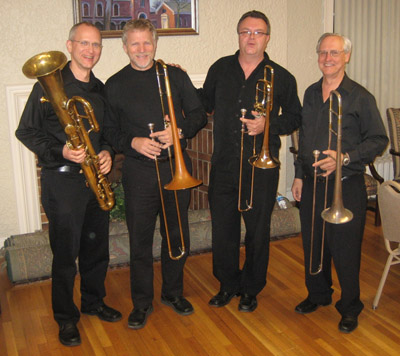 My week with Philharmonia Baroque, which culminated in four concerts in San Francisco, Palo Alto and Berkleley, was very rich, made particularly
satisfying by the collaboration I had with the three other members of the orchestra's low brass section, trombonists Richard Cheetham, McDowell "Mac" Kenley
and Douglas Thorley. All are experienced, active early and modern music players on both trombone and sackbut. During our many hours of rehearsals,
and through breaks and meals together, we enjoyed conversation about our shared eperiences. I came away from my time with these fine players greatly enriched.
The photo at left shows us in our warm up room before our final concert in Berkeley (left to right): myself, Doug, Richard and Mac.
My week with Philharmonia Baroque, which culminated in four concerts in San Francisco, Palo Alto and Berkleley, was very rich, made particularly
satisfying by the collaboration I had with the three other members of the orchestra's low brass section, trombonists Richard Cheetham, McDowell "Mac" Kenley
and Douglas Thorley. All are experienced, active early and modern music players on both trombone and sackbut. During our many hours of rehearsals,
and through breaks and meals together, we enjoyed conversation about our shared eperiences. I came away from my time with these fine players greatly enriched.
The photo at left shows us in our warm up room before our final concert in Berkeley (left to right): myself, Doug, Richard and Mac.
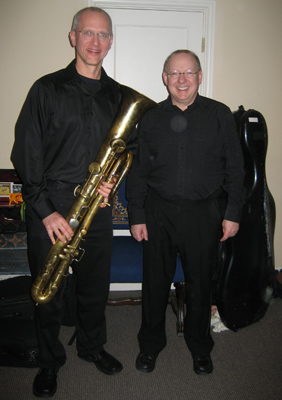 Conductor Nicholas McGegan (shown with me at left) was very enthusiastic about my playing ophicleide with PBO. In such a group, made up of 19th century wind
instruments and a relatively small string section by modern orchestra standards, the ophicleide brings a strong bass to the table. And it is not every concert
that finds PBO venturing so late into the 19th century in terms of repertoire. Mendelssohn's scoring is
ingenious, and to play this piece again (I had previously played ophicleide on MSND with the Boston Symphony under Seiji Ozawa and Neville Marriner,
and the bass trombone part under more conductors than I could count) on the exact date of what would have been Mendelssohn's 200th birthday was a rare
and rewarding experience. In addition, there were a number of players in the orchestra who I had worked with in other groups such as Boston Baroque
and the Handel & Haydn Society, including principal oboe Marc Schachman and principal trumpet John Thiessen. For the concerts in Berkeley, I was asked to
join John Prescott, PBO's pre-concert program annotator, in a discussion about the Mendelssohn's use of the ophicleide with appreciative audiences.
Thus continues my "missionary effort" to help redeem and establish the reputation of historical bass brasses like the serpent and ophicleide, and help
audiences see and hear what they can do in the hands of someone who works on them diligently and is sympathetic to each instrument's idiosyncratic aspects.
Conductor Nicholas McGegan (shown with me at left) was very enthusiastic about my playing ophicleide with PBO. In such a group, made up of 19th century wind
instruments and a relatively small string section by modern orchestra standards, the ophicleide brings a strong bass to the table. And it is not every concert
that finds PBO venturing so late into the 19th century in terms of repertoire. Mendelssohn's scoring is
ingenious, and to play this piece again (I had previously played ophicleide on MSND with the Boston Symphony under Seiji Ozawa and Neville Marriner,
and the bass trombone part under more conductors than I could count) on the exact date of what would have been Mendelssohn's 200th birthday was a rare
and rewarding experience. In addition, there were a number of players in the orchestra who I had worked with in other groups such as Boston Baroque
and the Handel & Haydn Society, including principal oboe Marc Schachman and principal trumpet John Thiessen. For the concerts in Berkeley, I was asked to
join John Prescott, PBO's pre-concert program annotator, in a discussion about the Mendelssohn's use of the ophicleide with appreciative audiences.
Thus continues my "missionary effort" to help redeem and establish the reputation of historical bass brasses like the serpent and ophicleide, and help
audiences see and hear what they can do in the hands of someone who works on them diligently and is sympathetic to each instrument's idiosyncratic aspects.
Throughout the week, I also had the opportunity to meet a number of other people who I had only known through email or telephone conversations. Principal among them was Galen Zinn, a Bay area trombonist whose helpful practice chart is one of the most popular downloads from my website. Such was the week - meeting friends old and new and sharing conversation on music and other areas of shared interest.
I left San Francisco deeply satisfied with how this 12 day trip turned out. As I write this, I reflect on the people who made this happen, and in particular the support of YAMAHA (which provided significant support to University of Washington and the Northwest Brass Band Festival), and the fine management of Philharmonia Baroque (including Jeffrey Phillips, Artistic Administrator) which came together to make the trip possible. As the first month of my sabbatical has drawn to a close and I am already preparing for other adventures, I am also especially indebted to the Boston Symphony for providing this sabbatical opportunity to me so I can explore new opportunities and refresh myself with rewarding experiences. Life is good!
The Minneapolis/St. Paul airport is a busy, noisy place, but I'm taking time to sit down and write this entry while reflecting on another meaningful trip of my sabbatical period from the Boston Symphony.
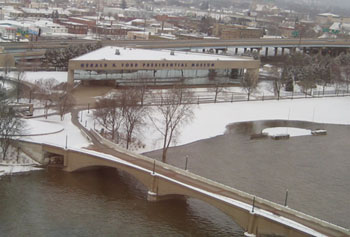 This trip began in Grand Rapids, Michigan. The destination was Highland Hills Baptist Church where I helped lead the first Highland Hills Festival of
Sacred Music. Connecting in Detroit, I was met in Grand Rapids by my friend Wayne Wilcox, who had organized the Festival. Many of you who are reading
this entry know of Wayne's fine work as a graphic designer: he did the design and layout for the artwork on my CDs
Le Monde du Serpent,
Cornerstone and the new pressing of
Proclamation.
He has also assisted me doing work for the
North American Brass Band Association
(NABBA), helping to design and
layout the NABBA Championships program for the last several word and advising me on technical issues relating to my start up period as editor of
NABBA's The Brass Band Bridge.
This trip began in Grand Rapids, Michigan. The destination was Highland Hills Baptist Church where I helped lead the first Highland Hills Festival of
Sacred Music. Connecting in Detroit, I was met in Grand Rapids by my friend Wayne Wilcox, who had organized the Festival. Many of you who are reading
this entry know of Wayne's fine work as a graphic designer: he did the design and layout for the artwork on my CDs
Le Monde du Serpent,
Cornerstone and the new pressing of
Proclamation.
He has also assisted me doing work for the
North American Brass Band Association
(NABBA), helping to design and
layout the NABBA Championships program for the last several word and advising me on technical issues relating to my start up period as editor of
NABBA's The Brass Band Bridge.
Concurrent with the Festival was a site visit to Grand Rapids by several members of the NABBA Board of Directors. Grand Rapids is one of several cities that would like to host NABBA's annual brass band Championships, so our committee (made of of Treasurer Jim Grate, Development Committee Chair Theresa MacDonald and myself, as NABBA's Vice President) enjoyed an extensive tour of the DeVos Center (including the convention center and the DeVos performance hall) and the Amway Grand Plaza Hotel. To say our hosts from the Grand Rapids Convention and Visitors Bureau were gracious and accommodating would be a profound understatement. Our six hours with our hosts gave us an excellent idea of what Grand Rapids would be like as a host city for our Championships. I confess to being more than a little surprised with the quality of the facilities, the services in the downtown area, and the vast array of cultural activities and museums (such as the Gerald R. Ford Presidential Museum, shown in the photo above, which was taken from my room in the Amway Grand Plaza Hotel) that were to be found in Grand Rapids. We on the NABBA site committee look forward to hearing more from Grand Rapids and other cities at our Annual Meeting of our Board of Directors in April as we make a decision on where to host our Championships in 2011 and beyond (the NABBA Championships in 2009 will be held in Louisville, Kentucky, and in 2010 in Raleigh, North Carolina).
 The NABBA site visit was very rewarding, but the main reason I came to Grand Rapids was to help lead the Highland Hills Festival of Sacred Music. This was a three day event that
brought together a Festival Choir made up of individuals from churches and colleges in the Grand Rapids area as well as two brass quintets. The
quitets were from Grand Valley State University (Blu Brass Quintet) and Cornerstone University (Cornerstone Brass Quintet). On Thursday and Friday, I conducted masterclasses for the brass players
while also rehearsing with them on four pieces that they would play as a combined ensemble on the Saturday evening gala concert. The photo at
right shows me leading the brass ensemble in concert on Saturday.
The NABBA site visit was very rewarding, but the main reason I came to Grand Rapids was to help lead the Highland Hills Festival of Sacred Music. This was a three day event that
brought together a Festival Choir made up of individuals from churches and colleges in the Grand Rapids area as well as two brass quintets. The
quitets were from Grand Valley State University (Blu Brass Quintet) and Cornerstone University (Cornerstone Brass Quintet). On Thursday and Friday, I conducted masterclasses for the brass players
while also rehearsing with them on four pieces that they would play as a combined ensemble on the Saturday evening gala concert. The photo at
right shows me leading the brass ensemble in concert on Saturday.
 The brass players were all very talented and were engaged in both our collaboration and their own performances. Mixing the two quintets proved to be
a stroke of good planning as they all interacted well and seemed to learn from one another. In addition to my conducting the brass players on the
concert, I also played serpent with the Festival Choir, in two pieces that I had recorded on my CD, Le Monde du Serpent: the opening track,
Alleluia and the final track, Nicholas Roze's Domine Salvum. It was nice to play thse pieces with a choir again, the first time I had done so
since making my recording. The choir was excellent and I was very pleased to introduce many in the group to the sight and sound of the serpent.
The brass players were all very talented and were engaged in both our collaboration and their own performances. Mixing the two quintets proved to be
a stroke of good planning as they all interacted well and seemed to learn from one another. In addition to my conducting the brass players on the
concert, I also played serpent with the Festival Choir, in two pieces that I had recorded on my CD, Le Monde du Serpent: the opening track,
Alleluia and the final track, Nicholas Roze's Domine Salvum. It was nice to play thse pieces with a choir again, the first time I had done so
since making my recording. The choir was excellent and I was very pleased to introduce many in the group to the sight and sound of the serpent.
 It was very satisfying to find the Highland Hills Baptist Church nearly full for the concert. Clearly Wayne Wilcox's diligent efforts in publicizing the
Festival had paid off. It was also nice to see so many people volunteering to make the Festival a success. Those who worked behind the senes to handle
the sound equipment, photography, programs, and overall logistics deserve high praise for their jobs well done. It was also nice to have good
interaction with the church's pastoral staff, including Associate Pastor of Music, Mark Warren (shown at right, next to Wayne Wilcox, center). A wrap-up session
at lunch on Sunday led to good discussion not only of the Festival, but of issues theological and relating to the work of praising God with music.
It was very satisfying to find the Highland Hills Baptist Church nearly full for the concert. Clearly Wayne Wilcox's diligent efforts in publicizing the
Festival had paid off. It was also nice to see so many people volunteering to make the Festival a success. Those who worked behind the senes to handle
the sound equipment, photography, programs, and overall logistics deserve high praise for their jobs well done. It was also nice to have good
interaction with the church's pastoral staff, including Associate Pastor of Music, Mark Warren (shown at right, next to Wayne Wilcox, center). A wrap-up session
at lunch on Sunday led to good discussion not only of the Festival, but of issues theological and relating to the work of praising God with music.
 I was pleased to stay in Grand Rapids through Sunday morning so I could worship at the Highland Hills Baptist Church. As part of the service, I played
two trombone solos that I had recorded on my CD
Cornerstone:
Be Thou My Vision and The Love of God. I also
accompanied the choir on its anthem, Come Ye Sinners, Poor and Needy. It was a very satisfying conclusion to a busy but rewarding few days
in Grand Rapids where I experienced a great mix of activities that touched on a number of my passions: working on behalf of brass bands around
North America, playing serpent and trombone, leading talented brass players, speaking of my Christian faith, and interacting with people on issues of
consequence.
I was pleased to stay in Grand Rapids through Sunday morning so I could worship at the Highland Hills Baptist Church. As part of the service, I played
two trombone solos that I had recorded on my CD
Cornerstone:
Be Thou My Vision and The Love of God. I also
accompanied the choir on its anthem, Come Ye Sinners, Poor and Needy. It was a very satisfying conclusion to a busy but rewarding few days
in Grand Rapids where I experienced a great mix of activities that touched on a number of my passions: working on behalf of brass bands around
North America, playing serpent and trombone, leading talented brass players, speaking of my Christian faith, and interacting with people on issues of
consequence.
Update: In May of 2009, The Baptist Bulletin, the Official Magazine of the General Association of Regular Baptist Churches, published a story about my visit to Highland Hills Baptist Church.
From Grand Rapids I flew to St. Paul, Minnesota, for two days at Northwestern College. Dr. Jeremy Kolwinska, Chairman of the Music Department and Professor of Low Brass at Northwestern was my host. Not to be confused with Northwestern University in Evanston, Illinois, Northwestern College is a Christian University that has a large music department (Billy Graham was the College's second President). Since 1970 it has been located on the site of a former Catholic Seminary which finds the College occupying some stunnig buildings with dramatic architectural statements.
 After a rehearsal with pianist Leonard Danek on Sunday evening, my attention turned to a full day on Monday. Northwestern College has a daily chapel
service and I was honored to be asked to speak to the students and faculty on Monday morning. To read my chapel message, titled, "Look for the Ancient Paths,"
click
HERE.
I was pleased to be able to challenge those listening while encouraging them in their Christian walk. Over lunch
(pictured at right) I led informal discussion with a group of students who posed interesting questions while we engaged in a very rewarding dialogue.
After a rehearsal with pianist Leonard Danek on Sunday evening, my attention turned to a full day on Monday. Northwestern College has a daily chapel
service and I was honored to be asked to speak to the students and faculty on Monday morning. To read my chapel message, titled, "Look for the Ancient Paths,"
click
HERE.
I was pleased to be able to challenge those listening while encouraging them in their Christian walk. Over lunch
(pictured at right) I led informal discussion with a group of students who posed interesting questions while we engaged in a very rewarding dialogue.
 My recital took place in Nazareth Chapel, a stunning room in the form of a Romanesque basillica - the photo at left shows me rehearsing with Lenny Danek
on Monday afternoon. With construction spanning 1921-1923, the Chapel was constructed by the
Ralph Guastavino Company of New York, utilizing both tiles and marble to create a majestic space for worship. Charles J. Connick created the magnificent
series of stained glass windows that frame the chapel. Nazareth Chapel had a very warm, expansive sound, and I was very gratified that my recital was
very well attended. I took particular pleasure in the number of trombone professors and students who were in attendance from the Twin Cities area,
including my good friend, R. Douglas Wright, principal trombonist of the Minnesota Orchestra. I have known Doug since his days as a student at New
England Conservatory of Music where Doug studied with my former Boston Symphony Orchestra trombone section colleague, Norman Bolter. Doug also played
in the New England Trombone Choir at New England Conservatory which I led for several years, and he was a regular substitute in the Boston Symphony and
played second trombone in the Boston Pops before he won his position with the Minnesota Orchestra.
My recital took place in Nazareth Chapel, a stunning room in the form of a Romanesque basillica - the photo at left shows me rehearsing with Lenny Danek
on Monday afternoon. With construction spanning 1921-1923, the Chapel was constructed by the
Ralph Guastavino Company of New York, utilizing both tiles and marble to create a majestic space for worship. Charles J. Connick created the magnificent
series of stained glass windows that frame the chapel. Nazareth Chapel had a very warm, expansive sound, and I was very gratified that my recital was
very well attended. I took particular pleasure in the number of trombone professors and students who were in attendance from the Twin Cities area,
including my good friend, R. Douglas Wright, principal trombonist of the Minnesota Orchestra. I have known Doug since his days as a student at New
England Conservatory of Music where Doug studied with my former Boston Symphony Orchestra trombone section colleague, Norman Bolter. Doug also played
in the New England Trombone Choir at New England Conservatory which I led for several years, and he was a regular substitute in the Boston Symphony and
played second trombone in the Boston Pops before he won his position with the Minnesota Orchestra.
 Following my recital, which included works both for trombone and serpent with piano, I conducted a master class, hearing three students from
Northwestern College in solos, and a jazz trombone quintet in a scintillating arrangement of Bart Howard's Fly Me To The Moon.
Later in the evening, Jeremy Kolwinska, Doug Wright and I retired to a local restaurant to enjoy a time of conversation - the photo at right
shows Jeremy (left) and Doug (right) with me, having done serious damage to a plate of nachos. Jeremy had
studied with Doug while working on his Doctorate at University of Minnesota, so the three of us had many mutual connections. That shared time reminded
me of one of the great joys of these sabbatical journeys: reconnecting with people I have not seen for some time while making new friendships in new
places.
Following my recital, which included works both for trombone and serpent with piano, I conducted a master class, hearing three students from
Northwestern College in solos, and a jazz trombone quintet in a scintillating arrangement of Bart Howard's Fly Me To The Moon.
Later in the evening, Jeremy Kolwinska, Doug Wright and I retired to a local restaurant to enjoy a time of conversation - the photo at right
shows Jeremy (left) and Doug (right) with me, having done serious damage to a plate of nachos. Jeremy had
studied with Doug while working on his Doctorate at University of Minnesota, so the three of us had many mutual connections. That shared time reminded
me of one of the great joys of these sabbatical journeys: reconnecting with people I have not seen for some time while making new friendships in new
places.
From St. Paul I rented a car and drove three hours north, to rural northern Wisconsin, for a two day visit with my former trombone teacher, Edward Kleinhammer.
Anyone who knows me, or has read anything on my website, or who has had a trombone lesson with me, knows the influence Edward Kleinhammer has had on me. Bass trombonist of the Chicago Symphony for 45 years (1940-1985), Mr. Kleinhammer was my trombone teacher during my years as a student at Wheaton College, Illinois (1974-76). Every week for two years - winter, spring, summer and fall - I took the train to downtown Chicago and walked to Mr. Kleinhammer's studio in the Fine Arts Building on Michigan Avenue for a lesson. I owe this fine man so much, and it was a delight to spend time with him and his wife in his snug home in the Wisconsis wilderness.
 Mr. Kleinhammer is nearly 90 years old. In robust health, we enjoyed a time of virtually non-stop conversation over two days. This was a private
time for us; it is not for me to share our conversations with readers of this diary. Mr. Kleinhammer has been my teacher, mentor, friend, confidant
and father-figure. In 1997 we published our book, Mastering the Trombone and we have enjoyed a close relationship since my time at Wheaton.
Our conversation covered a wide range of topics from trombone, orchestral playing, the "old days" of his years in the Chicago Symphony, and our
shared Christian faith. It was a rich, vibrant, special time with one of the most important relationships I have had in my lifetime. Mr. Kleinhammer's wife, Dessie, was a delightful hostess and their
dog, Ven, was always at our feet throughout the days. It is impossible for me to express the personal meaning of this time with Mr. Kleinhammer. But I
shall never forget it.
Mr. Kleinhammer is nearly 90 years old. In robust health, we enjoyed a time of virtually non-stop conversation over two days. This was a private
time for us; it is not for me to share our conversations with readers of this diary. Mr. Kleinhammer has been my teacher, mentor, friend, confidant
and father-figure. In 1997 we published our book, Mastering the Trombone and we have enjoyed a close relationship since my time at Wheaton.
Our conversation covered a wide range of topics from trombone, orchestral playing, the "old days" of his years in the Chicago Symphony, and our
shared Christian faith. It was a rich, vibrant, special time with one of the most important relationships I have had in my lifetime. Mr. Kleinhammer's wife, Dessie, was a delightful hostess and their
dog, Ven, was always at our feet throughout the days. It is impossible for me to express the personal meaning of this time with Mr. Kleinhammer. But I
shall never forget it.
 I left Wisconsin this morning (it was -7 degrees Farenheit when I woke up) with a long ride back to the Minneapolis/St. Paul airport. I spent the first hour listening to a new CD Mr. Kleinhammer
had given to me, Volume One of a two CD set of performances by the Chicago Symphony Trombone Quartet, recorded in 1967. Trombonists Jay Friedman,
Glenn Dodson, Frank Crisafulli and Edward Kleinhammer recorded a fine album that has just now been released. While I have been aware of these
recording sessions and Glenn Dodson had sent me a copy on DAT many years ago, it was great to see the album finally in a public release
so trombonists around the world can enjoy this model of trombone ensemble playing. After the CD concluded, I drove on to the airport in silence,
reflecting on the events of the last week, and taking in the sights of the rural upper mid-west. Fishing huts and trucks on frozen lakes, deer running
near the road, and ice building up on my rented car. So much has happened. Once again, I am so very grateful to the Boston Symphony for providing
me with this sabbatical opportunity, and to Yamaha Corporation for providing sponsorship to many of the places that I have visited (including
Highland Hills Baptist Church and Northwestern College). It will be good to be home for a few days before heading out once again. The days are passing
quickly, and I am deep into the second month of this time away from the Boston Symphony.
I left Wisconsin this morning (it was -7 degrees Farenheit when I woke up) with a long ride back to the Minneapolis/St. Paul airport. I spent the first hour listening to a new CD Mr. Kleinhammer
had given to me, Volume One of a two CD set of performances by the Chicago Symphony Trombone Quartet, recorded in 1967. Trombonists Jay Friedman,
Glenn Dodson, Frank Crisafulli and Edward Kleinhammer recorded a fine album that has just now been released. While I have been aware of these
recording sessions and Glenn Dodson had sent me a copy on DAT many years ago, it was great to see the album finally in a public release
so trombonists around the world can enjoy this model of trombone ensemble playing. After the CD concluded, I drove on to the airport in silence,
reflecting on the events of the last week, and taking in the sights of the rural upper mid-west. Fishing huts and trucks on frozen lakes, deer running
near the road, and ice building up on my rented car. So much has happened. Once again, I am so very grateful to the Boston Symphony for providing
me with this sabbatical opportunity, and to Yamaha Corporation for providing sponsorship to many of the places that I have visited (including
Highland Hills Baptist Church and Northwestern College). It will be good to be home for a few days before heading out once again. The days are passing
quickly, and I am deep into the second month of this time away from the Boston Symphony.
My trips and events keep coming; it is exhilirating to be doing so many things that are so enjoyable and which allow me to meet and work with both new people and old friends.
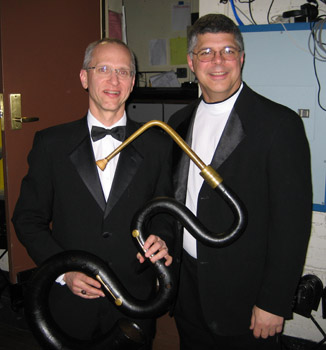 Earlier this week I took part in two events while at home in Boston.
Earlier this week I took part in two events while at home in Boston.
On Tuesday, I traveled to New Britain, Connecticut (near Hartford) to give a masterclass at Central Connecticut University. Scott Bean is the trombone teacher at CCSU while he is also a doctoral student at New England Conservatory. I enjoyed a very nice evening working with several talented CCSU students; the large audience was both engaged and engaging; in many respects this was a very rewarding masterclass. Chris Manners, a Yamaha area representative, was also in attendance and it gave me the opportunity to thank Yamaha once again for their generous support of my sabbatical activities.
I have been teaching at New England Conservatory of Music since I came to Boston in 1985 and have from time to time had opportunities to work with groups of students. I've played on chamber music recitals that some of my students have given, have been soloist with the NEC Honors Orchestra, conducted The New England Trombone Choir at New England Conservatory and given recitals and masterclasses there. Last year, I mentioned to NEC Jordan Winds conductor, William Drury, that I'd be on sabbatical and that perhaps there might be a time when I could play with a group of wind players at NEC. I suggested we play the arrangement of Beethoven's Septet, Op. 20 as arranged for winds by the 19th century composer Heinrich Crusell (edited by Mark Rogers) which Crusell retitled, Grand Serenade. The piece is a masterwork of chamber music and arranged for an unusual wind ensemble: flute, Eflat clarinet, two Bflat clarinets, trumpet, two horns, two bassoons, bass trombone and serpent. I played serpent in a performance of the work several years ago at Tanglewood along with some Fellows from the Tanglewood Music Center. I was pleased when Bill Drury enthusiastically embraced the idea of doing the Grand Serenade at NEC. The collaboration was a nice one; the students played very well and I had a rare opportunity to sit along side one of my students in performance, bass trombonist Adam Rainey who is a freshman at NEC. The photo at left shows Bill Drury and me backstage before the performance. I was very proud of the NEC students (the Eflat clarinet part is monstrous and was very capably played) and the appreciative audience left no doubt that the group made a good connection with those in attendance.
 Yesterday I travelled to Little Rock, for a planned weekend of sessions as guest conductor and clinician working with the
Natural State Brass Band.
I have had a very special relationship with this band for
several years. Rusty Morris, the NSBB's music director, is President of the
North American Brass Band Association; I serve as NABBA's Vice President. Rusty and I are good friends (read
my sabbatical entry for January 21 about our trip together to England on behalf of NABBA) and two years ago, I came to Little Rock to hold some clinic sessions with the band as they
were preparing for the NABBA Brass Band Championships. This is a very fine band and one made up of hard working, generous and nice people. From our very first
interaction together it was clear that we got on well and it was nice to be asked back again this year to help the band as they prepare their NABBA Championships program.
The NSBB is planning a tour of England in 2010 and I will be going with the band as a guest soloist.
Yesterday I travelled to Little Rock, for a planned weekend of sessions as guest conductor and clinician working with the
Natural State Brass Band.
I have had a very special relationship with this band for
several years. Rusty Morris, the NSBB's music director, is President of the
North American Brass Band Association; I serve as NABBA's Vice President. Rusty and I are good friends (read
my sabbatical entry for January 21 about our trip together to England on behalf of NABBA) and two years ago, I came to Little Rock to hold some clinic sessions with the band as they
were preparing for the NABBA Brass Band Championships. This is a very fine band and one made up of hard working, generous and nice people. From our very first
interaction together it was clear that we got on well and it was nice to be asked back again this year to help the band as they prepare their NABBA Championships program.
The NSBB is planning a tour of England in 2010 and I will be going with the band as a guest soloist.
 Coming to Little Rock has many known and unexpected pleasures. It is easy to hold stereotypes about different parts of the country and Arkansas is not immune from people
"up north" making uninformed comments and assumptions about the state. All I can say is, "Come on down and see with your own eyes." To be here is to enjoy a beautiful part of the country with
nice people. And fine food, too. Little Rock was host to the 2003 NABBA Championships and that visit was my first to Arkansas; coming back a third time this week has been
very enjoyable and satisfying.
Coming to Little Rock has many known and unexpected pleasures. It is easy to hold stereotypes about different parts of the country and Arkansas is not immune from people
"up north" making uninformed comments and assumptions about the state. All I can say is, "Come on down and see with your own eyes." To be here is to enjoy a beautiful part of the country with
nice people. And fine food, too. Little Rock was host to the 2003 NABBA Championships and that visit was my first to Arkansas; coming back a third time this week has been
very enjoyable and satisfying.
 I enjoyed many hours of intense rehearsal with the band (the photo above, left, shows me working with the band) and it was exciting to see the band respond to my comments and work hard to implement new nuances in their playing.
Rusty Morris is a rare conductor to give up his podium to a guest like me, but such is the nature of our relationship that we can work so well together. I was honored and
pleased - and, frankly, rendered speechless - when the NSBB President, Rico Belotti, announced that the band's board of directors had voted to name me the Natural State Brass Band's
Associate Conductor. The photo above (right) shows Rusty and me together at today's rehearsal. To add to this, the band presented me with a certificate naming me an "Arkansas Traveler," signed by the state's Governor and Secretary of State. These
kinds of things do not happen all the time to me, and I am very grateful to have an even closer relationship with this great group of people from the "Natural State." Tonight,
with our clinic sessions over, the band and I gathered at a fantastic local restaurant, The Catfish Hole (it is the kind of "local color," "hole-in-the-wall"
kind of restaurant that you simply have to visit to believe that places like this exist), and enjoyed great food, conversation and time together to celebrate
the end of an intense but very satisfying weekend. Kudos to the members of the Natural State Brass Band!
I enjoyed many hours of intense rehearsal with the band (the photo above, left, shows me working with the band) and it was exciting to see the band respond to my comments and work hard to implement new nuances in their playing.
Rusty Morris is a rare conductor to give up his podium to a guest like me, but such is the nature of our relationship that we can work so well together. I was honored and
pleased - and, frankly, rendered speechless - when the NSBB President, Rico Belotti, announced that the band's board of directors had voted to name me the Natural State Brass Band's
Associate Conductor. The photo above (right) shows Rusty and me together at today's rehearsal. To add to this, the band presented me with a certificate naming me an "Arkansas Traveler," signed by the state's Governor and Secretary of State. These
kinds of things do not happen all the time to me, and I am very grateful to have an even closer relationship with this great group of people from the "Natural State." Tonight,
with our clinic sessions over, the band and I gathered at a fantastic local restaurant, The Catfish Hole (it is the kind of "local color," "hole-in-the-wall"
kind of restaurant that you simply have to visit to believe that places like this exist), and enjoyed great food, conversation and time together to celebrate
the end of an intense but very satisfying weekend. Kudos to the members of the Natural State Brass Band!
The weather outside is, as they say, frightful, and hail, high winds and heavy rain have delayed my flight back to Boston from Chicago's O'Hare International Airport. This provides me with an opportunity to get a head start on this diary entry as I conclude the last of my lengthy, multi-leg trips of my sabbatical journey.
 Four years ago I embarked on a masterclass tour of Texas universities, visiting five schools in a week's time. When my sabbatical
from the Boston Symphony was approved, I thought this would be another opportunity to visit the state of "Six Flags," building on my
last visit while visiting some new places. This time I was pleased to have two invitations to have extended residencies at schools in Texas - one I had visited
before and a new one - and they proved to be immensely rewarding and very different from one another.
Four years ago I embarked on a masterclass tour of Texas universities, visiting five schools in a week's time. When my sabbatical
from the Boston Symphony was approved, I thought this would be another opportunity to visit the state of "Six Flags," building on my
last visit while visiting some new places. This time I was pleased to have two invitations to have extended residencies at schools in Texas - one I had visited
before and a new one - and they proved to be immensely rewarding and very different from one another.
Nathaniel Brickens is Professor of Trombone at University of Texas, Austin, and a past President of the International Trombone Association. I got to know Dr. Brickens during my last visit to Texas. He presides over an excellent trombone program at UT, and this year he has over 20 trombone players in the University of Texas Trombone Choir. Nat had asked me if I would do a number of things during my visit this time while expanding on the masterclass I had given at UT a few years ago. And expand my activities we did!
During my three days in Austin - which, by the way, were accompanied by beautiful weather - I performed a full recital and gave three masterclasses in addition to teaching private lessons to four University of Texas bass trombone students. This was a busy, intense time of activity but all of it was very satisfying. The students at UT are highly motivated and accomplished players. It took a little time to get used to the Texan courtesy - I am not accustomed to being addressed as "Sir" back home in Boston - but I very quickly adopted to the different pace and style of the Lone Star State.
I throughly enjoyed conducting a masterclass with the UT Trombone choir (pictured above, at right). The ensemble includes members who play alto and contrabass trombone in addtion to tenor and bass trombone; thus the whole trombone "family" was represented. I found the group to be very responsive as I worked through Donald Hundsberger's fine arrangement of Bach's Passacaglia in c minor, Ralph Sauer's eight-part arrangement of Haydn's Achieved is the Glorious Work from The Creation and Derek Bourgeois' Osteoblast. Nat Brickens was very kind in turning over the baton to his ensemble so I could bring some different ideas to the group.
 My recital consisted both of works for bass trombone and piano as well as two pieces for solo bass trombone accompanied by trombone
ensemble. Chuck Dillard, one of the fine collaborative pianists at UT, was my excellent accompanist in four pieces, including Robert Schumann's beautiful love song,
Widmung, and bass trombone concerti by Alexi Lebedev and my friend, Eric Ewazen. Nat Brickens and I (pictured at left)
also played a duet with piano, my arrangement of Johann Sebastian Bach's duo from Cantata 78, Wir eilen mit schwachen, doch emsigen Schritten.
Working with Nat was a distinct pleasure; always the gentleman, he is also a very fine trombonist, and our blend and like-minded
concept of the piece made for a very nice collaboration.
My recital consisted both of works for bass trombone and piano as well as two pieces for solo bass trombone accompanied by trombone
ensemble. Chuck Dillard, one of the fine collaborative pianists at UT, was my excellent accompanist in four pieces, including Robert Schumann's beautiful love song,
Widmung, and bass trombone concerti by Alexi Lebedev and my friend, Eric Ewazen. Nat Brickens and I (pictured at left)
also played a duet with piano, my arrangement of Johann Sebastian Bach's duo from Cantata 78, Wir eilen mit schwachen, doch emsigen Schritten.
Working with Nat was a distinct pleasure; always the gentleman, he is also a very fine trombonist, and our blend and like-minded
concept of the piece made for a very nice collaboration.
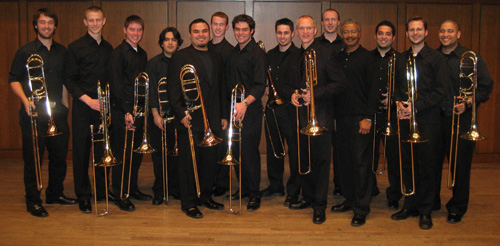 The last two pieces on the recital were solos where I was accompanied by members of the UT Trombone Choir (shown at right following
the concert with Dr. Brickens and me), with Nat conducting. John Stevens' The Chief, written in tribute to the Eastman School
of Music's great trombone teacher, the late Emory Remington, and Tommy Pederson's laid back, Blue Topaz which I had
recorded on my first solo CD,
Proclamation, were on the agenda. The Choir proved to be
an engaged, engaging and sensitive accompanying ensemble, and it was a pleasure to work with them.
The last two pieces on the recital were solos where I was accompanied by members of the UT Trombone Choir (shown at right following
the concert with Dr. Brickens and me), with Nat conducting. John Stevens' The Chief, written in tribute to the Eastman School
of Music's great trombone teacher, the late Emory Remington, and Tommy Pederson's laid back, Blue Topaz which I had
recorded on my first solo CD,
Proclamation, were on the agenda. The Choir proved to be
an engaged, engaging and sensitive accompanying ensemble, and it was a pleasure to work with them.
During my time at UT, I also gave a masterclass for trombone students at the University where I had an opportunity to work with several soloists and an orchestral trombone section, and give another masterclass that was designed for area high school students. A bonus of my time in Austin was meeting up with friends Charles Villarubbia (tuba) and his wife Mary Ann Gedegian (flute) who lived and worked in Boston (including substituting with the Boston Symphony) for many years before moving to Texas to teach at UT. Add to this some fine food (I managed to consume excellent representative samples of what I was told are the three main Texan food groups: Mexican food, fried chicken and barbecue) and I left Austin very pleased with the fast-paced three days I had there.
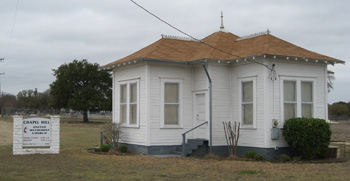 Living in "the big city" most of my life, I take particular pleasure in driving through rural America. My recent trip to Minnesota and
Wisconsin (see my diary entry for February 19) involved a long drive from St. Paul to northern Wisconsin, a fascinating trip past frozen lakes
and dairy farms in sub-zero temperatures. On my Texas trip, it was sensible, for a variety of reasons, for me to fly into Dallas and rent a car to drive to my Texas destinations
on this trip. Of course, driving in Texas is unlike driving anywhere else in the country, for you can drive for many hours to get
from one place to another. I covered over 200 miles of driving from Dallas to Austin; by way of reference, Massachusetts is only 130
miles wide and if I drove over 200 miles in New England, I could easily set foot in five states.
Living in "the big city" most of my life, I take particular pleasure in driving through rural America. My recent trip to Minnesota and
Wisconsin (see my diary entry for February 19) involved a long drive from St. Paul to northern Wisconsin, a fascinating trip past frozen lakes
and dairy farms in sub-zero temperatures. On my Texas trip, it was sensible, for a variety of reasons, for me to fly into Dallas and rent a car to drive to my Texas destinations
on this trip. Of course, driving in Texas is unlike driving anywhere else in the country, for you can drive for many hours to get
from one place to another. I covered over 200 miles of driving from Dallas to Austin; by way of reference, Massachusetts is only 130
miles wide and if I drove over 200 miles in New England, I could easily set foot in five states.
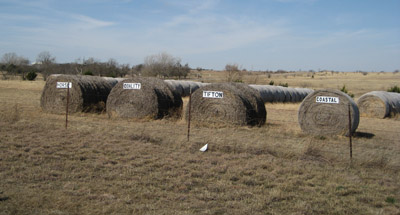 The drive from Austin to my next destination, Tarleton State University in Stephenville, Texas, was fascinating. I contrast to my
long drive in Minnesota and Wisconsin, this trip was undertaken when the temperature was 80 degrees. I found myself stopping
every few miles and making a u-turn to take in some sight that I could only glimpse while traveling at 70 miles per hour (the Texas speed limit even on
two lane, rural roads). The extraordinarily small United Methodist Church in Chapel Hill, Texas (pictured above, left) and the
farmer who was selling four different kinds of hay (pictured at right) - I didn't even KNOW there were four kinds of hay, which are,
from left to right, Horse, Quality, Tifton and Coastal - are just a couple of the fascinating sites I took in on this interesting journey.
Long flat roads, farm land as far as the eye
could see (a few times, I was certain I could see the curve of the earth, so long and flat was the vista before me), cattle, sheep and goat farms, and billboards advertising all manner of things that were new to me (one restaurant
sported a sign encouraging people to stop in on "Pork Butt Fridays") made the long drive pass quickly.
The drive from Austin to my next destination, Tarleton State University in Stephenville, Texas, was fascinating. I contrast to my
long drive in Minnesota and Wisconsin, this trip was undertaken when the temperature was 80 degrees. I found myself stopping
every few miles and making a u-turn to take in some sight that I could only glimpse while traveling at 70 miles per hour (the Texas speed limit even on
two lane, rural roads). The extraordinarily small United Methodist Church in Chapel Hill, Texas (pictured above, left) and the
farmer who was selling four different kinds of hay (pictured at right) - I didn't even KNOW there were four kinds of hay, which are,
from left to right, Horse, Quality, Tifton and Coastal - are just a couple of the fascinating sites I took in on this interesting journey.
Long flat roads, farm land as far as the eye
could see (a few times, I was certain I could see the curve of the earth, so long and flat was the vista before me), cattle, sheep and goat farms, and billboards advertising all manner of things that were new to me (one restaurant
sported a sign encouraging people to stop in on "Pork Butt Fridays") made the long drive pass quickly.
An Update: After I posted this diary entry, one of my students at New England Conservatory, Adam Rainey, said that my characterization of the hay bales I saw on my way to Stephenville was not exactly accurate. I very kindly received an education on hay from Adam and his mother; here are his comments:
When Mr. Yeo visited Stephenville, Texas, he came across four bales of hay on the side of the road. He said that these types of hay were Tifton, Coastal, Quality and Horse. Having grown up in the rural midsection of our country, I know that hay is named by the type of grass it comes from. Tifton and Coastal are types of hay, but Quality is not. It is simply the seller's best. And finally, Horse is not a type of hay. No matter how funny it is to imagine a bale of horses, it doesn't exist. My mother and I loved Mr. Yeo's enthusiasm with his find, but his city-boy upbringing shone right through. (Don't blame Mr. Yeo for the mistake, though - - the hay was falsely advertised by the farmer).
There you have it!
 Tarleton State University, located in Stephenville, Texas, seemed to pop up from the middle of nowhere. Actually, after driving for so
many hours, I felt like I WAS in the middle of nowhere. After driving miles through small
towns and hundreds of acres of farms and rural scenes, Stephenville came to life very quickly. Part of the Texas A&M network of schools,
Tarleton State has an active music department and a vibrant campus life that belies the fact that it is very much part of the
rural Texas geography.
Tarleton State University, located in Stephenville, Texas, seemed to pop up from the middle of nowhere. Actually, after driving for so
many hours, I felt like I WAS in the middle of nowhere. After driving miles through small
towns and hundreds of acres of farms and rural scenes, Stephenville came to life very quickly. Part of the Texas A&M network of schools,
Tarleton State has an active music department and a vibrant campus life that belies the fact that it is very much part of the
rural Texas geography.
Upon checking into my hotel, I found a generous "welcome basket" full of food and items that rapidly acquainted me with Tarleton State life. I had to smile as I looked through the basket: this trip had been set up many months earlier - in fact, it was one of the first events that got booked once I announced my sabbatical - and I sensed right away that my coming to Tarleton State was an "event" for the campus.
I came to Tarleton State at the request of Jonathan Hooper who, until his retirement in 2008, had been director of bands at the school.
A bass trombonist himself, we enjoyed a nice email correspondence over several months as I told him how much I enjoy coming to "small-market" schools that
don't always have guest artists like me come by. After Jonathan's retirement, I was contacted by his successor, interim director
of bands Dr. Reggie Houze, who put together a very nice visit for me.
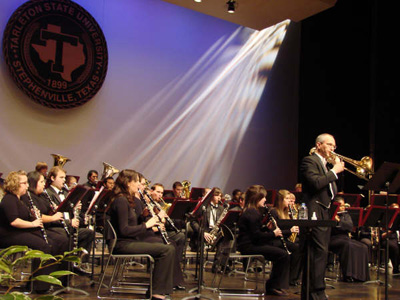 The Tarleton State University Wind Ensemble (shown with me at right during our concert together) is made up mostly of music education majors who work with Dr. Houze each week. I was pleased
to be asked to play a solo with the Wind Ensemble and chose to play Gordon Langford's Proclamation, the title track from
my solo CD of the same name.
While originally written for me for bass trombone with brass band accompaniment, Gordon arranged
the piece for wind band accompaniment and this performance at Tarleton State was my first with the new accompaniment. This particular
concert centered around the induction of new members of the "John Tarleton Society," a group of the University's most generous donors
whose Society is named after the founder of the school. In addition to my performance of Proclamation, associate director of
bands Richard Bahner conducted a piece and former director Jonathan Hooper was asked to conduct the group. I was honored to be a part of
this special concert for several reasons, not the least of which was that Jonathan Hooper was honored by several special
presentations as the evening progressed.
The Tarleton State University Wind Ensemble (shown with me at right during our concert together) is made up mostly of music education majors who work with Dr. Houze each week. I was pleased
to be asked to play a solo with the Wind Ensemble and chose to play Gordon Langford's Proclamation, the title track from
my solo CD of the same name.
While originally written for me for bass trombone with brass band accompaniment, Gordon arranged
the piece for wind band accompaniment and this performance at Tarleton State was my first with the new accompaniment. This particular
concert centered around the induction of new members of the "John Tarleton Society," a group of the University's most generous donors
whose Society is named after the founder of the school. In addition to my performance of Proclamation, associate director of
bands Richard Bahner conducted a piece and former director Jonathan Hooper was asked to conduct the group. I was honored to be a part of
this special concert for several reasons, not the least of which was that Jonathan Hooper was honored by several special
presentations as the evening progressed.
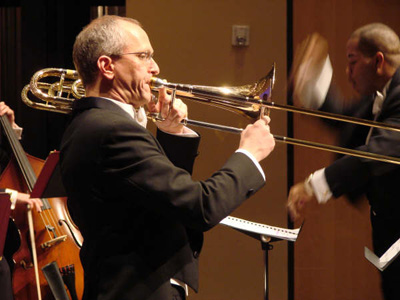 Dr. Houze (pictured with me at left) proved to be a sensitive accompanist and after my performance of Proclamation, I played
a solo encore, Riffs by Daniel Schnyder.
Dr. Houze (pictured with me at left) proved to be a sensitive accompanist and after my performance of Proclamation, I played
a solo encore, Riffs by Daniel Schnyder.
The evening concluded with several receptions (the photo below, right, shows Richard Bahner, Reggie Houze, me and Jonathan Hooper after the concert), and the next day, I gave a masterclass for students at Tarleton State before heading off to the Hard-8-BBQ for a lunch that was all it had been built up to be.
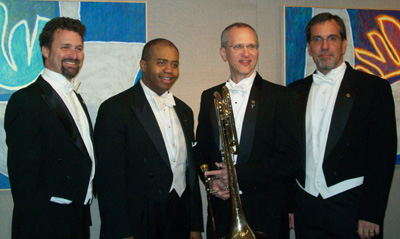 I have to say that my interaction with students at Tarleton State was a real joy. I had many one-on-one conversations with students
about career goals and substantial issues of faith and learning. Several weeks ago, students in the instrumental music department
began something called "Half Caszj Wednesdays", in which students and faculty alike dress down half way on Wednesdays, wearing pajamas or lounge
wear instead of trousers. I was happy to play along in solidarity with the students, and my wearing my Boston Red Sox lounge pants (with sport coat on top) helped me
make immediate connections with many in the music department. It was good fun, and a reminder of how important it is to have a good time while
engaging in the serious business of holding one another to high standards in order to prepare for life in an increasingly
competitive musical environment.
I have to say that my interaction with students at Tarleton State was a real joy. I had many one-on-one conversations with students
about career goals and substantial issues of faith and learning. Several weeks ago, students in the instrumental music department
began something called "Half Caszj Wednesdays", in which students and faculty alike dress down half way on Wednesdays, wearing pajamas or lounge
wear instead of trousers. I was happy to play along in solidarity with the students, and my wearing my Boston Red Sox lounge pants (with sport coat on top) helped me
make immediate connections with many in the music department. It was good fun, and a reminder of how important it is to have a good time while
engaging in the serious business of holding one another to high standards in order to prepare for life in an increasingly
competitive musical environment.
And, once again, I am very grateful to YAMAHA for their generous sponsorship of my events in Texas. Over and over I keep hearing the same thing from my hosts: YAMAHA has been a pleasure to work with and a great help in making my visits as successful as they have been.
My travels then took me to Chicago for a trip of great pleasure - visiting my oldest daughter, Linda. Having visited my youngest
daughter, Robin (and her husband, John),
during my trip to San Francisco last month, I wanted to get to Wheaton, Illinois so I will have visited both of our girls during my
sabbatical period. My
travels brought me to Wheaton, Illinois, home of
Wheaton College
where all of us - my wife, our daughters, and I - went to college.
 To say that Wheaton is a special place to our family would be a profound understatement. I transferred to Wheaton in
the summer of 1974, after my freshman year at Indiana University. It was at Wheaton that I studied with Edward
Kleinhammer, who was at the time bass trombonist of the Chicago Symphony Orchestra (see my diary entry for February 19 for
my comments on my recent visit to visit him at his home in northern Wisconsin). My wife and I were married in 1975 while we were students at
Wheaton, and with our daughters also attending there, we have two generations of strong memories and connections with the school whose
motto is, "For Christ and His Kingdom."
To say that Wheaton is a special place to our family would be a profound understatement. I transferred to Wheaton in
the summer of 1974, after my freshman year at Indiana University. It was at Wheaton that I studied with Edward
Kleinhammer, who was at the time bass trombonist of the Chicago Symphony Orchestra (see my diary entry for February 19 for
my comments on my recent visit to visit him at his home in northern Wisconsin). My wife and I were married in 1975 while we were students at
Wheaton, and with our daughters also attending there, we have two generations of strong memories and connections with the school whose
motto is, "For Christ and His Kingdom."
Linda and I had a lot of things planned for our visit, including a trip to downtown Chicago to attend a concert by the Chicago Symphony Orchestra. While I have played concerts in Chicago as a member of the Boston Symphony Orchestra, I had not heard the CSO play in Orchestra Hall (now called "Symphony Center") since I graduated from Wheaton in 1976. Taking the train downtown, walking to Michigan Avenue, enjoying lunch and then the long climb up to the "gallery" in the hall, was a trip down memory lane. During my years at Wheaton, my wife and I attended many Chicago Symphony concerts and I had dozens of lessons at Mr. Kleinhammer's studio in the Fine Arts Building on Michigan Avenue. Sharing the concert with Linda was a special experience on many levels - not the least because she is also a bass trombonist and had played one of the featured works on the program - Janacek's Sinfonietta - as a member of the Northbrook (Illinois) Symphony as I had played it many times with the Boston Symphony.
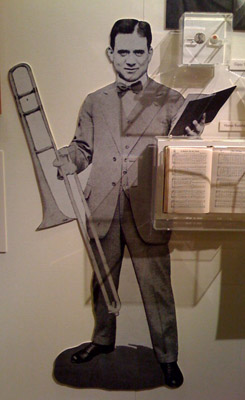 The rest of the weekend was taken up with a variety of enjoyable activities: I very much wanted this visit to Wheaton to be a private
one and I did not wish to be "on duty" with any trombone activities at the College. There is time on sabbatical for rest, vacation and special times
with family, so I walked around Wheaton's campus quietly. There will be other times for me to work with students at Wheaton and
visit with other friends. This visit was for Linda and me.
The rest of the weekend was taken up with a variety of enjoyable activities: I very much wanted this visit to Wheaton to be a private
one and I did not wish to be "on duty" with any trombone activities at the College. There is time on sabbatical for rest, vacation and special times
with family, so I walked around Wheaton's campus quietly. There will be other times for me to work with students at Wheaton and
visit with other friends. This visit was for Linda and me.
Wheaton College is home to the Billy Graham Center, and the Center houses a museum of the life and ministry of one of Wheaton's most famous alums, Billy Graham. I have been to the museum before and each time I have gone it has affected me differently. This time the exhibits seemed to have an especially powerful effect on me.
 The museum's exhibits tell the story of the spread of the Christian Gospel throughout North America, from the Puritan Pilgrims to the present
day. They may have been there when I visited in the past, but I don't recall having ever seeing photographs in the exhibits of Homer Rodeheaver (music
director for evangelist Billy Sunday), hymnal
in one hand and his trombone in the other (at right) and Cliff Barrows (long time song leader for Billy Graham) sitting next to Billy Graham, also with his trombone in his hand
(at left). I was reminded of my own calling both as a servant of Christ and as a trombonist, and how every aspect of my music making -
even my very life - is informed by my Christian faith. At many of the master classes I have given around the country, I have repeated
a wise axiom I first heard from John Swallow, who before his retirement taught trombone at New England Conservatory of Music and
Yale University, and played in the New York Brass Quintet and the Chicago Symphony. Swallow would enourage his students to have a
balanced, pluralistic life and would say, "Trombone is something I do. It is not who I am." To Swallow's wise words I add an axiom of
my own: "My Christian faith is who I am. It is not something I do." These two axioms - when taken together - frame my life as
Christian and musician. The Billy Graham Center Museum reminded me of this in new ways, and I found our time in the Museum to be
both a great challenge and a great encouragement.
The museum's exhibits tell the story of the spread of the Christian Gospel throughout North America, from the Puritan Pilgrims to the present
day. They may have been there when I visited in the past, but I don't recall having ever seeing photographs in the exhibits of Homer Rodeheaver (music
director for evangelist Billy Sunday), hymnal
in one hand and his trombone in the other (at right) and Cliff Barrows (long time song leader for Billy Graham) sitting next to Billy Graham, also with his trombone in his hand
(at left). I was reminded of my own calling both as a servant of Christ and as a trombonist, and how every aspect of my music making -
even my very life - is informed by my Christian faith. At many of the master classes I have given around the country, I have repeated
a wise axiom I first heard from John Swallow, who before his retirement taught trombone at New England Conservatory of Music and
Yale University, and played in the New York Brass Quintet and the Chicago Symphony. Swallow would enourage his students to have a
balanced, pluralistic life and would say, "Trombone is something I do. It is not who I am." To Swallow's wise words I add an axiom of
my own: "My Christian faith is who I am. It is not something I do." These two axioms - when taken together - frame my life as
Christian and musician. The Billy Graham Center Museum reminded me of this in new ways, and I found our time in the Museum to be
both a great challenge and a great encouragement.
Perhaps the most powerful of many strong moments in the Museum took place in its "Hall of Witnesses." In this area of the Museum, large tapestries are hung that represent a number of people from New Testament times to the present who had a profound impact on the spreading of Christ's Gospel. I found myself deeply moved by two particular quotations that have imprinted themselves in my mind in an indelible way; in fact, I have thought of them so often in the last few days that I have committed them to memory:

When you have Him you have all, but you have also lost all when you lose Him.
Stay with Christ, although your eyes do not see Him and your reason does not grasp Him.
(Martin Luther)

But if we know Him first as Savior by being born again from above,
We know that he did not come to teach us only;
He came to make us what He teaches we should be.
(Oswald Chambers)
What a trip this has been. Once again, one of my sabbatical journeys has combined several joys of my life: conducting, teaching, a trombone recital, solo performance with an accompanying ensemble, interaction with students and a visit with one of my familly. And through this there is the over-arching work of Christ in my life which informs all I think, do and say. My flight home from Chicago was delayed even more than when I first started this entry. When I left worship at College Church this morning, pea sized hail was falling as I had never seen. As a result, many flights from O'Hare were delayed or cancelled this afternoon and evening. I feel fortunate that I had planned to go home on American Airlines flight 154, a flight that, as a result of cancellations earlier in the day, had a standby list of over 60 people. I finish this essay while finally in the air to return home to Boston; I shall post it tomorrow morning. But this delay has not resulted in lost time, as it has given me time to reflect on the events of the last days while at the same time looking forward to what lies ahead.
My sabbatical has been a rich time of exploration but it is not all about doing things musical. Built into this time away from the Boston Symphony are times of rest and refreshment, including vacations with my wife, Pat. During the hard winter in Boston, we like to get away from time to time to warmer climates and this most recent sabbatical trip brought us to the desert southwest of America, to two national parks including one of our favorite places in the world.
We planned a trip that would bring us to Phoenix, Arizona and then gradually northward to Grand Canyon National Park and Zion National Park for several days of hiking. We got our first taste of the American National Park system in 1978 when we took a six week cross-country camping vacation from New York City (where Pat had just completed her undergraduate degree at Columbia University and I was in the middle of my master's degree program at New York University), visiting 11 national parks during that time. In more recent years, we have purposed to visit particular parks for extended periods of time. While Acadia National Park in Maine is one of our favorite places, most of the National Parks we enjoy are in the western part of America and they include some of the best known and most beautiful places in the world: Zion, Bryce, Grand Canyon, Yosemite, Glacier and many more. We enjoy the climate of the west as well as the dramatic, colorful desert scenery. Hiking for several hours each day brings us deep into God's great creation, away from the "rim watchers" who visit parks only to snap photos and eat in restaurants. I have heard it told that 90% of visitors to National Parks don't travel more than a few feet from their cars or their hotel front doors. How sad! It is by getting IN the parks - on the remote hiking trails - that you can escape the rush and noise of our modern times and let your thoughts roam to different things.

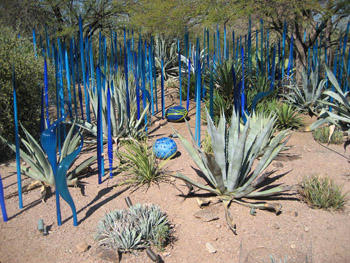 On this trip, we decided to add in a trip to a city - Phoenix - before we headed north to the Parks. You have to fly somewhere when you come to the west,
and when we visit Zion, we usually fly to Las Vegas (and get out of there as quickly as possible - we are not Vegas people in any way!) and drive north.
But this time, with Grand Canyon in the mix, flying to Phoenix made the most sense and it gave us a chance to explore that city a bit.
The weather in Phoenix was comfortable and dry, a nice change from what we left behind in Boston. Our first destination was the Desert Botanical Gardens.
Having vacationed in the southwest so many times (this was our seventh trip to Zion National Park and our fourth to the Grand Canyon), we thought we would
enjoy the Gardens and the extensive desert flora that we see so often on the hiking trails. We were not prepared for a tremendous bonus at the Gardens: an
installation of art glass by the glass blower Chihuly. While I have long admired stained glass in the great Gothic cathedrals of Europe and Britain, I was
unprepared for the stunning beauty of Chihuly's glass that integrated so well with the desert flowers and cacti.
On this trip, we decided to add in a trip to a city - Phoenix - before we headed north to the Parks. You have to fly somewhere when you come to the west,
and when we visit Zion, we usually fly to Las Vegas (and get out of there as quickly as possible - we are not Vegas people in any way!) and drive north.
But this time, with Grand Canyon in the mix, flying to Phoenix made the most sense and it gave us a chance to explore that city a bit.
The weather in Phoenix was comfortable and dry, a nice change from what we left behind in Boston. Our first destination was the Desert Botanical Gardens.
Having vacationed in the southwest so many times (this was our seventh trip to Zion National Park and our fourth to the Grand Canyon), we thought we would
enjoy the Gardens and the extensive desert flora that we see so often on the hiking trails. We were not prepared for a tremendous bonus at the Gardens: an
installation of art glass by the glass blower Chihuly. While I have long admired stained glass in the great Gothic cathedrals of Europe and Britain, I was
unprepared for the stunning beauty of Chihuly's glass that integrated so well with the desert flowers and cacti.
The photos at left and at right give you just a small taste of Chihuly's artistry, set alongside nicely laid out displays of desert beauty. His glass ranged from tall, elegant flutes of colored glass to more intricate, large scale pieces. The juxtoposition of the man-made artistry next to the God-made artistry was evocative, and we thoroughly enjoyed our time at the Gardens. While we would have enjoyed it immensely without Chihuly's glass work, that added bonus made our visit even the more fascinating. This visit to the Desert Botanical Gardens has left lasting images in my mind that I continue to revisit. What an unexpected delight this was.
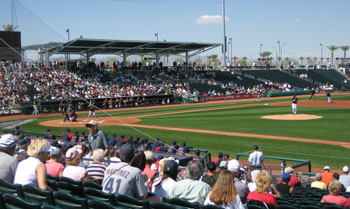 While in Phoenix, we took in a spring training baseball game at the Cleveland Indians' new field, Goodyear Ballpark in Goodyear, Arizona, a suburb of Phoenix.
While football is the sport my wife and I enjoy the most, we follow the Boston Red Sox closely and watch a good amount of baseball in the summer. The Red Sox
hold their spring training in Florida (the "Citrus League") and it was Pat's idea for us to take in a game with teams that train in the "Cactus League" in
Arizona. We were so glad we did. Goodyear Ballpark is a full size baseball field with a miniature stadium around it. There were about 5,500 people in
attendance at the game, an intimate, relaxed setting in perfect weather that made for a great afternoon. The Indians defeated the Oakland A's (I confess that
was the first - and probably last - time we cheered for the Indians, who are American League rivals of the Red Sox) in a game that started off fast for the Indians
and then nearly blew up for them when their middle relief pitching allowed Oakland to mount a comeback late in the game.
While in Phoenix, we took in a spring training baseball game at the Cleveland Indians' new field, Goodyear Ballpark in Goodyear, Arizona, a suburb of Phoenix.
While football is the sport my wife and I enjoy the most, we follow the Boston Red Sox closely and watch a good amount of baseball in the summer. The Red Sox
hold their spring training in Florida (the "Citrus League") and it was Pat's idea for us to take in a game with teams that train in the "Cactus League" in
Arizona. We were so glad we did. Goodyear Ballpark is a full size baseball field with a miniature stadium around it. There were about 5,500 people in
attendance at the game, an intimate, relaxed setting in perfect weather that made for a great afternoon. The Indians defeated the Oakland A's (I confess that
was the first - and probably last - time we cheered for the Indians, who are American League rivals of the Red Sox) in a game that started off fast for the Indians
and then nearly blew up for them when their middle relief pitching allowed Oakland to mount a comeback late in the game.
 We enjoyed conversation with a number of other fans, ate ballpark food, and just enjoyed the relaxed pace of the whole experience. An unexpected bonus was
an announcement that Hall of Fame pitcher Bob Feller, who was one of the greatest pitchers of all time (he played his whole career for the Indians) would be
signing autographs throughout the game. Bob Feller! I had to shake the hand of this man who my father had talked about during my childhood. It is not every day
you get to meet a Hall of Famer, much less one who is 90 years old! My few moments with Feller (photo at left) were a treat, as he signed a photo for me and
we shook hands. I was impressed by his graciousness, and the conversation I had with others on line to meet Feller was just another part of the
whole enjoyable baseball experience we had on that fine day.
We enjoyed conversation with a number of other fans, ate ballpark food, and just enjoyed the relaxed pace of the whole experience. An unexpected bonus was
an announcement that Hall of Fame pitcher Bob Feller, who was one of the greatest pitchers of all time (he played his whole career for the Indians) would be
signing autographs throughout the game. Bob Feller! I had to shake the hand of this man who my father had talked about during my childhood. It is not every day
you get to meet a Hall of Famer, much less one who is 90 years old! My few moments with Feller (photo at left) were a treat, as he signed a photo for me and
we shook hands. I was impressed by his graciousness, and the conversation I had with others on line to meet Feller was just another part of the
whole enjoyable baseball experience we had on that fine day.
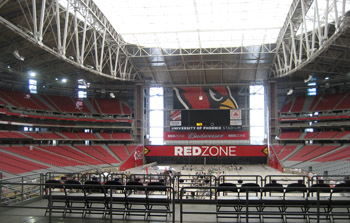 I mentioned above that the sport that Pat and I follow most closely is football. The New England Patriots are enjoying a great run right now, having been in
four Super Bowls in recent years - winning three. We enjoyed Super Bowl XLIII, held this past February between the Arizona Cardinals and the Pittsburgh Steelers.
It was easy to cheer for the Cardinals, a team that had not had much success in recent years but which got to the Super Bowl with veteran Kurt Warner. Warner
is not only a fine quarterback, but a classy, Christian man who is a great role model for many. We thought we would take a tour of the Cardinals' stadium -
University of Phoenix Stadium. The tour was fun, and it was nice to see behind the scenes, visit locker rooms and luxury
boxes, and see the domed stadium's natural grass field rolled outside where it "lives" before being rolled back inside on game day. The stadium was the site
of Super Bowl XLII when the Patriots lost to the New York Giants, but that did not dampen our enjoyment at all. While we will always be Patriots fans, if, in
retirement we relocate to the southwest, we will look forward to cheering for the Cardinals.
I mentioned above that the sport that Pat and I follow most closely is football. The New England Patriots are enjoying a great run right now, having been in
four Super Bowls in recent years - winning three. We enjoyed Super Bowl XLIII, held this past February between the Arizona Cardinals and the Pittsburgh Steelers.
It was easy to cheer for the Cardinals, a team that had not had much success in recent years but which got to the Super Bowl with veteran Kurt Warner. Warner
is not only a fine quarterback, but a classy, Christian man who is a great role model for many. We thought we would take a tour of the Cardinals' stadium -
University of Phoenix Stadium. The tour was fun, and it was nice to see behind the scenes, visit locker rooms and luxury
boxes, and see the domed stadium's natural grass field rolled outside where it "lives" before being rolled back inside on game day. The stadium was the site
of Super Bowl XLII when the Patriots lost to the New York Giants, but that did not dampen our enjoyment at all. While we will always be Patriots fans, if, in
retirement we relocate to the southwest, we will look forward to cheering for the Cardinals.
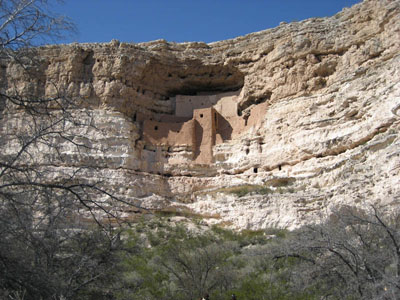 We took our time driving up to the Grand Canyon South Rim, overnighting in Prescott, Arizona while taking some short hikes to get ready for the bigger hikes
that awaited. On our way, we visited several National Monuments - Montezuma's Castle and Tuzigoot - sites where American Indians had built dwellings that
had long since been abandoned. Montezuma's Castle (which has nothing to do with the ancient Mexican of the same name) was a cliff dwelling, perched high
off the ground in a nook of Navajo sandstone. We had seen the massive Indian cliff dwellings in Mesa Verde, Colorado during our 1978 western trip, and
Montezuma's Castle was very much a Mesa Verde in miniature. Seeing these kinds of dwellings is always a strong experience that raises so many questions: How
did they build the structure? Why did they choose to live there? Why did they leave? Definitive answers to these and other questions are lost to antiquity,
but it is always interesting to see ruins like these and think through the questions while enjoying the impressive beauty of the dwelling.
We took our time driving up to the Grand Canyon South Rim, overnighting in Prescott, Arizona while taking some short hikes to get ready for the bigger hikes
that awaited. On our way, we visited several National Monuments - Montezuma's Castle and Tuzigoot - sites where American Indians had built dwellings that
had long since been abandoned. Montezuma's Castle (which has nothing to do with the ancient Mexican of the same name) was a cliff dwelling, perched high
off the ground in a nook of Navajo sandstone. We had seen the massive Indian cliff dwellings in Mesa Verde, Colorado during our 1978 western trip, and
Montezuma's Castle was very much a Mesa Verde in miniature. Seeing these kinds of dwellings is always a strong experience that raises so many questions: How
did they build the structure? Why did they choose to live there? Why did they leave? Definitive answers to these and other questions are lost to antiquity,
but it is always interesting to see ruins like these and think through the questions while enjoying the impressive beauty of the dwelling.
The Grand Canyon is one of those sites that cannot be explained in photographs, paintings or words. To do so is to engage in a futile exercise since nothing - apart from seeing it with your own eyes - can prepare you for the enormity of the "big hole in the ground" (as many in Arizona call it). Yet when we visit the Grand Canyon, I cannot stop taking pictures, which later can jog the memory of my eyes to remember particular things I saw.
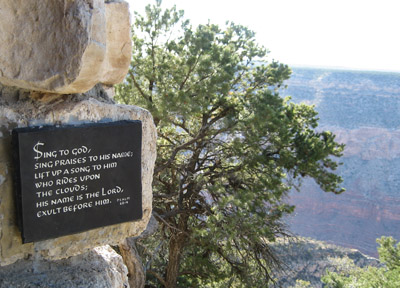 We spent our first day at the Grand Canyon hiking the rim trail, from our hotel, the historic El Tovar Hotel (built in 1905 and one of the great lodges of
the western National Parks), to Hermit's rest at the western end of the rim trail. While Grand Canyon National Park encompasses thousands of acres, the South Rim
and North Rim of the Parks have only limited development and rim trails. As I mentioned above, most people just stand at the rim and look out; while we could have
taken a shuttle bus to Hermit's Rest, we hiked most of the way, enjoying the great panoramic vistas without the crush of the crowds that tend to stay near the
hotels in Grand Canyon village. At Hermit's Rest, we found one of three plaques found throughout the park that provides an inspiring perspective to the
beauty we kept seeing before us (photo at left, of Psalm 68:4).
We spent our first day at the Grand Canyon hiking the rim trail, from our hotel, the historic El Tovar Hotel (built in 1905 and one of the great lodges of
the western National Parks), to Hermit's rest at the western end of the rim trail. While Grand Canyon National Park encompasses thousands of acres, the South Rim
and North Rim of the Parks have only limited development and rim trails. As I mentioned above, most people just stand at the rim and look out; while we could have
taken a shuttle bus to Hermit's Rest, we hiked most of the way, enjoying the great panoramic vistas without the crush of the crowds that tend to stay near the
hotels in Grand Canyon village. At Hermit's Rest, we found one of three plaques found throughout the park that provides an inspiring perspective to the
beauty we kept seeing before us (photo at left, of Psalm 68:4).
Sing to God; sing praises to His name. Lift up a song to Him who rides upon the clouds; His name is the Lord, exult before Him.
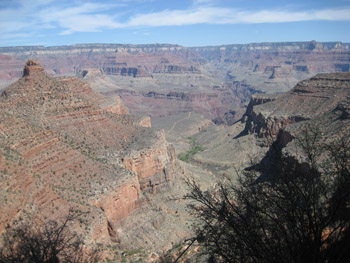 The next day we set out on the Bright Angel Trail to hike down into the Canyon. Most hiking that we do takes us up to mountain peaks where we can take
in great sceneic vistas. But the Grand Canyon is different - you hike DOWN first, and then have to go back UP. As a result, you need to plan carefully, as
it is a lot easier to go down than go back up again. The rule of thumb is that it will take you twice as long to get back up as it did to get down. With no water
available on the trail down into the Canyon, you must take all you think you need. Many who decide to go down into the Canyon don't plan well and the Park Service
spends more than a little time rescuing people who have experienced dehydration or hypothermia as a result of bad planning. It also never surprises me when I
see people completely ill-equipped for such a rigorous hike - people wearing sneakers or even sandals, with no water or food, assuming they would just go for a
"walk in the park." Pat and I were well equipped for our hike which took us a few miles into the Canyon before we turned around for the journey back up to the
rim. While we have never hiked all the way to the bottom of the Canyon (where the Colorado River is still doing its work of eroding and continuing to
widen and deepen the Canyon), we have enjoyed these hikes part way down where we have gotten a lot closer to the unique beauty and majesty of the Grand Canyon.
The next day we set out on the Bright Angel Trail to hike down into the Canyon. Most hiking that we do takes us up to mountain peaks where we can take
in great sceneic vistas. But the Grand Canyon is different - you hike DOWN first, and then have to go back UP. As a result, you need to plan carefully, as
it is a lot easier to go down than go back up again. The rule of thumb is that it will take you twice as long to get back up as it did to get down. With no water
available on the trail down into the Canyon, you must take all you think you need. Many who decide to go down into the Canyon don't plan well and the Park Service
spends more than a little time rescuing people who have experienced dehydration or hypothermia as a result of bad planning. It also never surprises me when I
see people completely ill-equipped for such a rigorous hike - people wearing sneakers or even sandals, with no water or food, assuming they would just go for a
"walk in the park." Pat and I were well equipped for our hike which took us a few miles into the Canyon before we turned around for the journey back up to the
rim. While we have never hiked all the way to the bottom of the Canyon (where the Colorado River is still doing its work of eroding and continuing to
widen and deepen the Canyon), we have enjoyed these hikes part way down where we have gotten a lot closer to the unique beauty and majesty of the Grand Canyon.
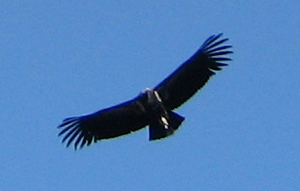 As we were walking along the rim one evening before dinner, we found ourselves alone on the trail walking to the east, enjoying the setting sun. We
noticed birds flying nearby and were aware, from a previous visit to the Park, that California condors - the immense, endangered bird with a nine foot wing
span - had been reintroduced to the Park several years ago. We had seen them on a trip to the Grand Canyon nine years ago, and were delighted to find several
condors flying overhead (photo at left). We had a private air show for awhile, as we watched three condors (and a hawk) do their majestic dance in flight. Condors, we
have learned, flap their wings only an average of six times an hour, mostly riding thermal air currents in their search for food. It was just another of many
unexpected sights during our time on the South Rim.
As we were walking along the rim one evening before dinner, we found ourselves alone on the trail walking to the east, enjoying the setting sun. We
noticed birds flying nearby and were aware, from a previous visit to the Park, that California condors - the immense, endangered bird with a nine foot wing
span - had been reintroduced to the Park several years ago. We had seen them on a trip to the Grand Canyon nine years ago, and were delighted to find several
condors flying overhead (photo at left). We had a private air show for awhile, as we watched three condors (and a hawk) do their majestic dance in flight. Condors, we
have learned, flap their wings only an average of six times an hour, mostly riding thermal air currents in their search for food. It was just another of many
unexpected sights during our time on the South Rim.
I mentioned earlier that we stayed at the historic El Tovar Hotel on the Rim. We are making a project of staying in many of these historic hotels that were built by the great railroad companies of the early twentieth century. They have great elegance while they fit in so well with the natural scenery. The El Tovar was no exception. In addition to its interesting architecture, fine restaurant and dramatic lobby design, there were surprises as well. Above one of the hotel's porches was the following quotation, taken from the concluding paragraph of C.A. Higgins' 1902 essay on the Grand Canyon, The Titan of Chasms:


Our trip out of the canyon to begin our journey north to Zion took us along the rim to the east, to the east entrance of the Park, at Desert View. On the way, I did something I had always wanted to do - play my trombone into the Grand Canyon. It took a little doing to find a scenic overlook where there were not others enjoying the view - the last thing I wanted to do was disturb the contemplations of someone who was taking in the great vistas before us. But we managed to find two overlooks where I was able to get out my trombone and play a few notes. It did surprise me that there was no echo as I played into the Canyon - after thinking about it, it made perfect sense: playing into the Grand Canyon is not like playing into a small slot canyon or playing up from the bottom. The Canyon is just too wide and deep for there to be any resonance from a trombone or any voice. But at least I did it and I had to smile as I put the horn in the case. By the way, the trombone I have in my hands in the photos above is my Yamaha Compact Trombone, model YSL-350C. The trombone is in C/B flat, with only six positions. Designed for your players with short arms, it has the great advantage of being very small and compact; it easily fits in an airplane overhead compartment and is much easier to manage when I'm on a hiking vacation than my regular YBL-822G bass trombone. This way I'm able to keep in shape while on vacation and not have the hassle of negotiating a large case on airplanes.
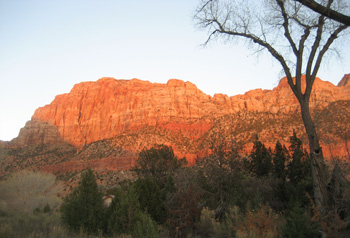 I have often told people that Zion National Park is my favorite place on earth. I have traveled around the globe more times than I can count but it is Zion that
is the most special place to me. But I cannot explain it. How can you explain the emotion you feel when being overwhelmed by tremendous beauty, but
beauty you can get up close to and touch? How can I explain how I feel when I see the beutiful earth-toned colors of rock mixed with wildflowers, blue sky and
running water? I can't. I don't have words to explain it. The beautiful red and white Navajo and Kayanta sandstone combines to give the landscape rich hues; this, along
with the massive rock formations that have been eroded over time surround one with artistry on the grandest scale. There is also the fact that many of the
formations in Zion were given names in 1916 by Methodist minister Frederick Vining Fisher that are evocative of Biblical images: places such as the West Temple
and the Altar of Sacrifice, the Great White Throne and Angel's Landing, the Court of the Patriarchs and the Watchman (pictured at left). Each has its own
special look and feel and on this, our seventh trip to Zion, it all seemed so familiar and comfortable, while at the same time surprising us at every turn.
I have often told people that Zion National Park is my favorite place on earth. I have traveled around the globe more times than I can count but it is Zion that
is the most special place to me. But I cannot explain it. How can you explain the emotion you feel when being overwhelmed by tremendous beauty, but
beauty you can get up close to and touch? How can I explain how I feel when I see the beutiful earth-toned colors of rock mixed with wildflowers, blue sky and
running water? I can't. I don't have words to explain it. The beautiful red and white Navajo and Kayanta sandstone combines to give the landscape rich hues; this, along
with the massive rock formations that have been eroded over time surround one with artistry on the grandest scale. There is also the fact that many of the
formations in Zion were given names in 1916 by Methodist minister Frederick Vining Fisher that are evocative of Biblical images: places such as the West Temple
and the Altar of Sacrifice, the Great White Throne and Angel's Landing, the Court of the Patriarchs and the Watchman (pictured at left). Each has its own
special look and feel and on this, our seventh trip to Zion, it all seemed so familiar and comfortable, while at the same time surprising us at every turn.
 Having been to Zion so frequently, we had already enjoyed most of the trails in the Park that are available to us. We had never been to Zion in March and wondered
whether snow would impact our visit. It did, despite temperatures during our visit being in the mid- to upper 70s. There is still deep snow in the high country and Zion is just
beginning to get the major spring snow melt. One indication of the melting snow at this time of year was to observe the change in the flow rate of the Virgin
River during our visit. On our second day in the part, the Virgin was flowing at about 104 cubic feet per second (cfs). By the time we left, after the warm days
we enjoyed, the flow rate was over 140 cfs. With a flow rate that fast, hikers are prohibited from hiking in The Narrows, one of the most popular hikes in the
Park that has you hiking IN the river first up, and then down stream in the midst of the towering canyon walls around you. One of the hikes we wanted to take, to
Deer Trap Mountain, was not an option as the road to it is still covered with
snow and is unpassable. Snow was visible on some of the formations in Zion Canyon and on one of our hikes, we encountered enough snow that we had to make
some choices as to how we were going to negotiate it.
Having been to Zion so frequently, we had already enjoyed most of the trails in the Park that are available to us. We had never been to Zion in March and wondered
whether snow would impact our visit. It did, despite temperatures during our visit being in the mid- to upper 70s. There is still deep snow in the high country and Zion is just
beginning to get the major spring snow melt. One indication of the melting snow at this time of year was to observe the change in the flow rate of the Virgin
River during our visit. On our second day in the part, the Virgin was flowing at about 104 cubic feet per second (cfs). By the time we left, after the warm days
we enjoyed, the flow rate was over 140 cfs. With a flow rate that fast, hikers are prohibited from hiking in The Narrows, one of the most popular hikes in the
Park that has you hiking IN the river first up, and then down stream in the midst of the towering canyon walls around you. One of the hikes we wanted to take, to
Deer Trap Mountain, was not an option as the road to it is still covered with
snow and is unpassable. Snow was visible on some of the formations in Zion Canyon and on one of our hikes, we encountered enough snow that we had to make
some choices as to how we were going to negotiate it.
 Our hikes this time took us back to Angel's Landing, one of the most popular hikes in the Park - the photo at right shows Pat and me on our way down one of the
many switchbacks on the trail. Near the end of the hike, we took a detour to some of the West Rim Trail, something we had never done before, which brought us
even higher than Angel's Landing and which afforded us some new views of Zion Canyon as well as other places we had hiked to in the past including Observation
point and Cable Mountain.
Our hikes this time took us back to Angel's Landing, one of the most popular hikes in the Park - the photo at right shows Pat and me on our way down one of the
many switchbacks on the trail. Near the end of the hike, we took a detour to some of the West Rim Trail, something we had never done before, which brought us
even higher than Angel's Landing and which afforded us some new views of Zion Canyon as well as other places we had hiked to in the past including Observation
point and Cable Mountain.
We did go on another hike that was new to us, to Hidden Canyon. Like Angel's Landing, this hike has a tremendous vertical rise and requires one to negotiate some parts of the trail that are very narrow with steep dropoffs on one side. The National Park Service has installed chains into the wall of the Canyon to assist hikers in safely negotiating this treacherous portion of the trail. The photo at left shows my left hand as I carefully made my way along one of these slippery and narrow trails. The reward at the end of the hike was a nice natural arch as well as more panaromic vistas of parts of the Park we had never seen before.
We concluded our days at Zion with a hike on the Watchman Trail. This is a hike we have taken every time we have visited Zion National Park. It is not by any means the longest or most strenuous hike in the park - it can easily be negotiated in 1.5 hours or so. But it has such a dramatic view at the end of the trail that we never fail to be moved and impressed by the reward we get. From the formation known as the Watchman to the Towers of the Virgin (it is the Virgin River that runs through Zion Canyon), the West Temple and the altar of sacrifice (with its distinctive red streaks running down), the Watchman trail reminds us once again why we love coming back to Zion. And back again. And again.
While atop the sandstone formation that made up the end of the Watchman trail, I took a 360 degree panoramic movie of the scene. I used my small Canon camera; while the quality is not nearly at a professional level, it does give you an idea of what Zion holds for its visitors. Click below to see my video of the view from the end of the Watchman Trail.
We left Zion to head back to Phoenix and then home to Boston, through the Park's east entrance which brought us through the engineering marvel that is the Zion-Mount Carmel Tunnel. The tunnel was blasted through a mountain and is approached through a dramatic set of switchbacks that bring you vertically up the face of the mountain. Once through the tunnel, we enjoyed seeing the east side of Zion National Park one more time, with its sandstone "hoodoos", Checkerboard Mesa and other formations that seem transplanted from other-worldly landscapes. The nearly 400 mile journey back to Phoenix was eventful, with a gusty wind all day long that included a nearly 30 minute violent sand storm. Not something I am used to in my life in the northeast.
It will not be long before we return to Zion again, of that I am sure. It is a place that acts like a strong magnet to us, calling us back to enjoy what God has put there for our pleasure.
With this entry, I near the mid-point of my sabbatical from the Boston Symphony. It will soon be time to start another page on my website to record the next three months of adventures and observations. I remain grateful, once again, to the BSO for giving me this great opportunity to have a sabbatical, to YAMAHA for providing sponsorship to so many schools and institutions that in turn supports my being able to visit them, and to all those who have - in any way - contributed to this joyful, reflective, inspiring and thought-provoking time of my life. More anon, friends.
|
|